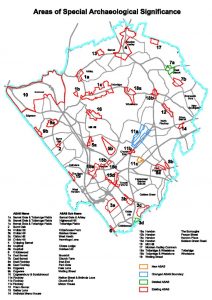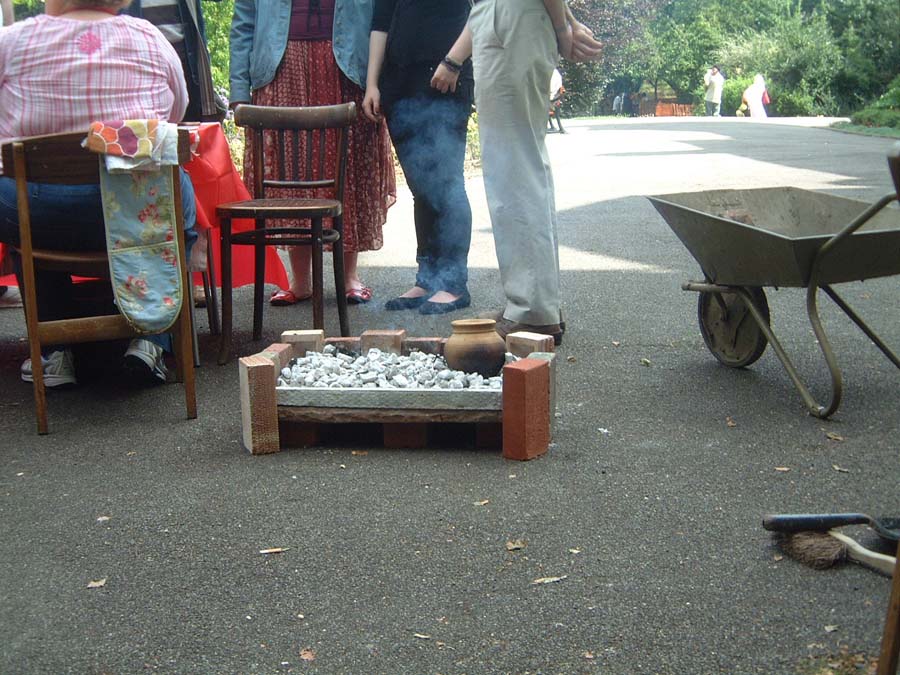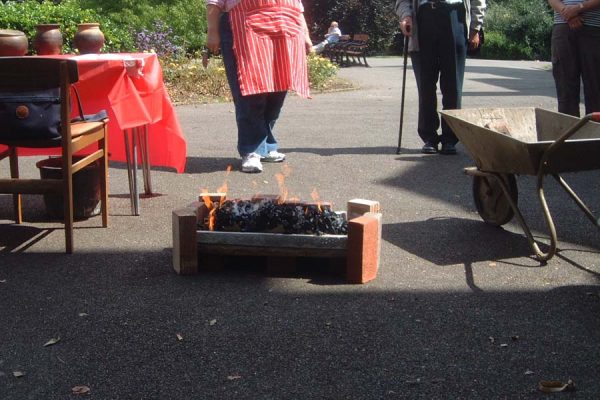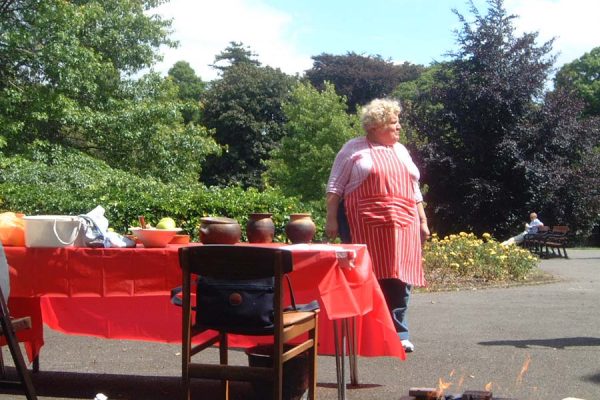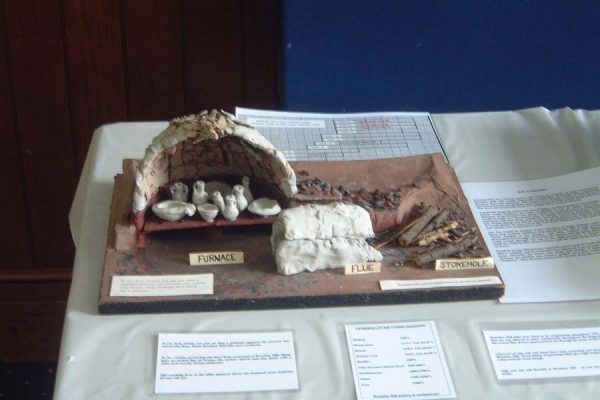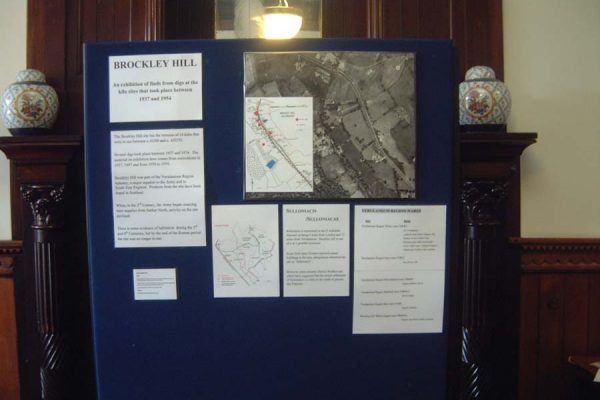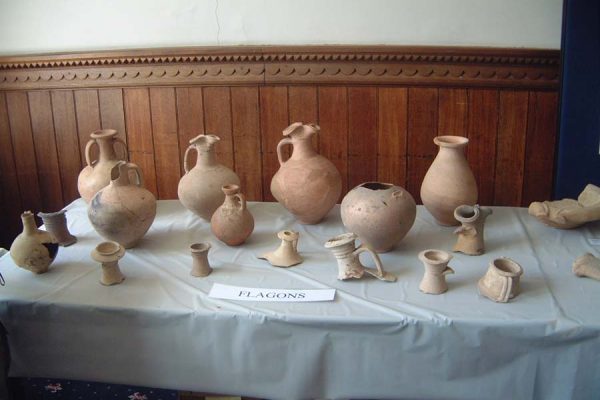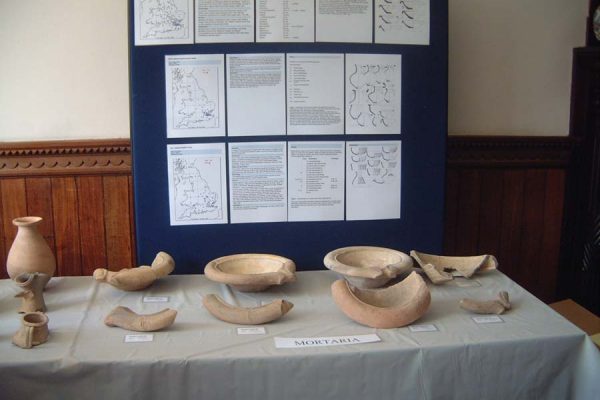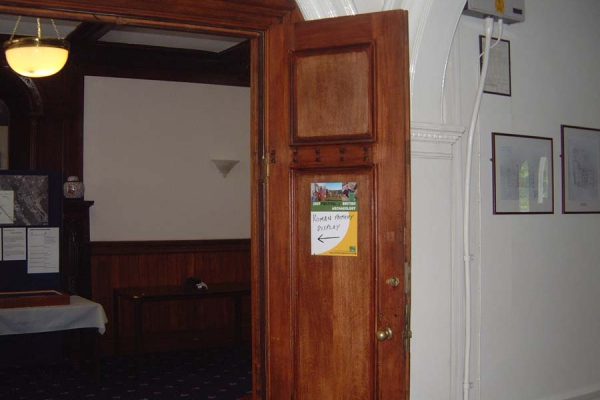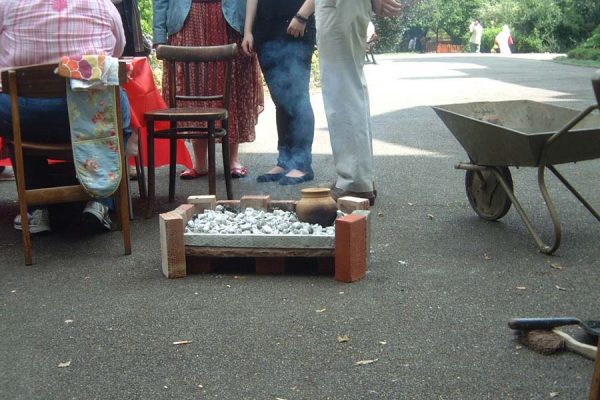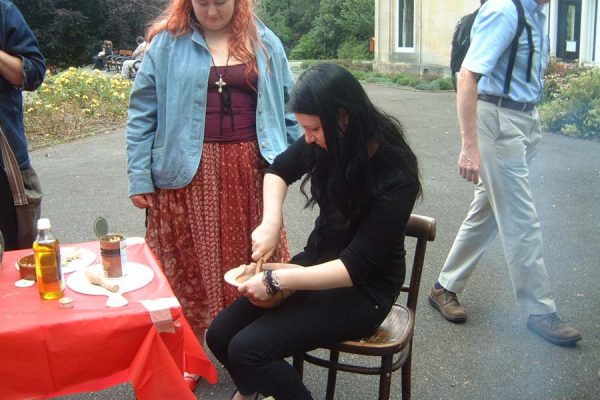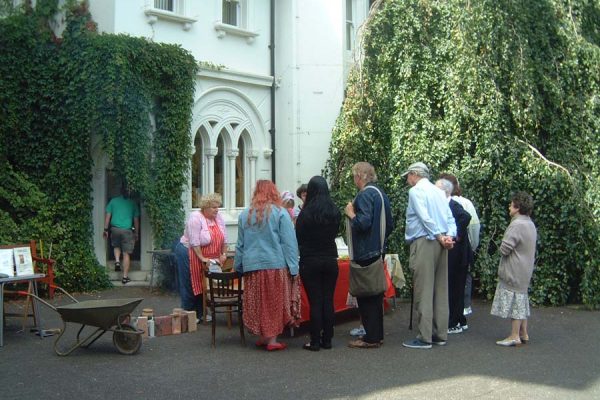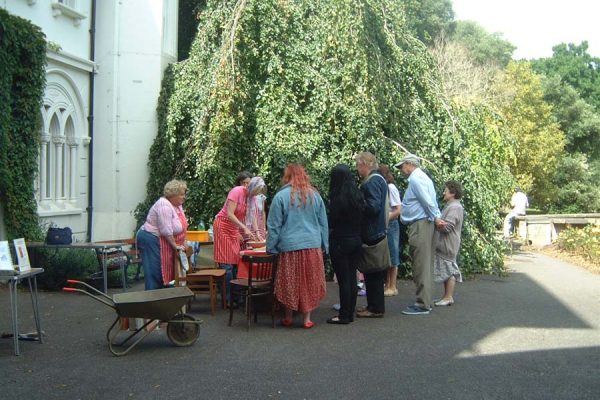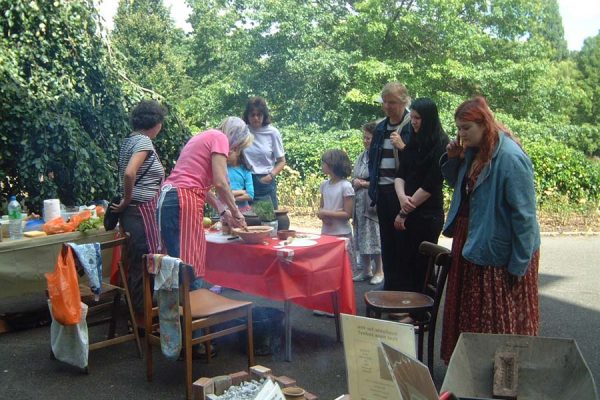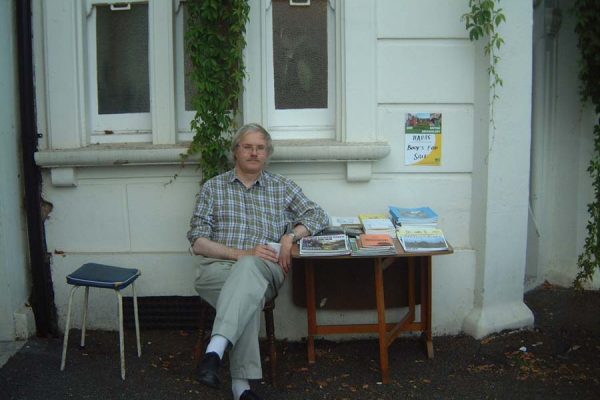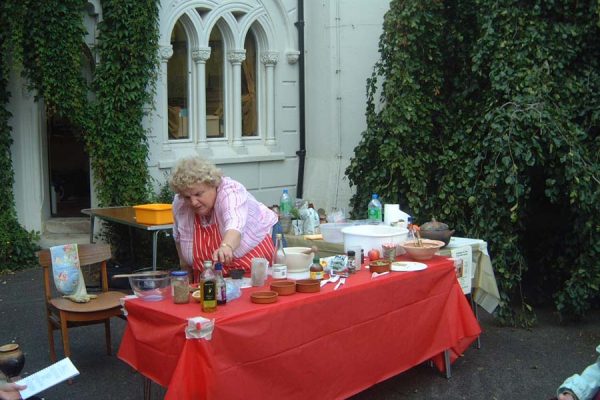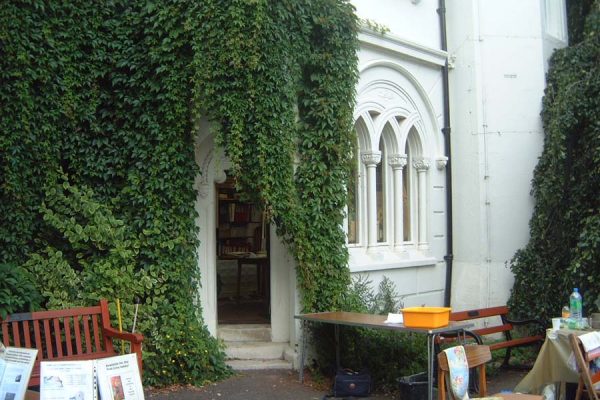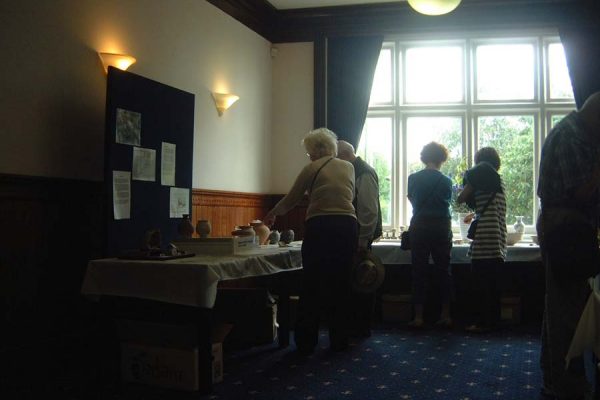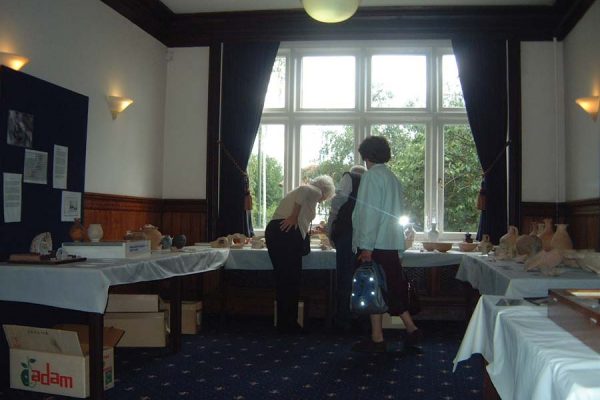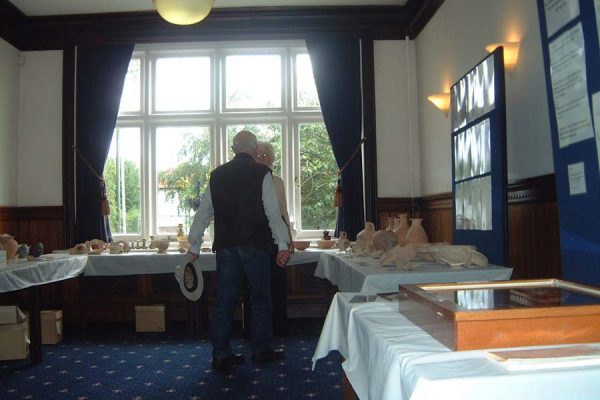|
No. 557 AUGUST 2017 Edited by Vicki Baldwin
HADAS DIARY
Monday 25th to Friday 29th September: Trip to Frodsham Lectures start again with: Tuesday 10th October 2017: The Curtain Playhouse excavations by Heather Knight MOLA Tuesday 14th November 2017: The Battle of Barnet Project by Sam Wilson Lectures start at 7.45 for 8.00pm in the Drawing Room, Avenue House, 17 East End Road, Finchley N3 3QE. Buses 13, 143, 326 & 460 pass close by, and it is five to ten minutes’ walk from Finchley Central Station (Northern Line). Tea/coffee and biscuits follow the talk.
STOP PRESS Members in Hendon, Colindale and Edgware and anyone else who is interested: URBAN VISION Last Free Training Event for the Barnet Local List Review Following the success of the past three training events and due to demand we have added one last date to the training programme. Our aim is to provide skills and training opportunities to volunteers who are keen to assist us in identifying new buildings and structures to compile a comprehensive new Local List of heritage assets in the borough and join our 43 current volunteers! For our current volunteers please feel free to join us if you would like a refresher, you are more than welcome! The local list nominations are critical to the recording and documentation of our built heritage assets. Your time and interest as a volunteer will help to provide up to date information on the existing Local List. You can also help identify and discover new entries to the local list. For further information about the current local list please visit:
This final free event will provide you with the background, training and practical demonstration of what we need and how you can directly help. This will include information about how to identify, research and locally list potential heritage assets. At the event volunteers will be given the opportunity to choose an area to survey and receive a comprehensive volunteer pack. The details of the free training event are: Time: Tuesday 8th August 2017 14:00-15:30 Location: Hendon Town Hall, Committee Room 3, The Burroughs, Hendon, London, NW4 4BG How to book: Places are limited and booking is essential, in order to reserve your place, or to find out more, email Hannah.barter@uvns.org, together with the names of all delegates and if applicable the group you are representing or please call the office with these details on 01538 386 221.
Londinium – The City’s Roman Heritage via Sue Willetts Starting at the end of July, a three month programme of activity celebrating the City’s Roman heritage will begin. The link to the website is here www.visitlondon.com/romans Of particular interest is a panel discussion at the Museum of London with Peter Marsden and Max Hebditch on 2 September, where they will be discussing excavation in the post-war period. https://www.cityoflondon.gov.uk/things-to-do/visit-the-city/whats-on/londinium-events/Pages/trowels-at-dawn.aspx
From Joe Sullivan, Heritage Outreach Officer at RAF Museum, Colindale via Don Cooper Historic Hendon As part of the redevelopment of the RAF Museum site in Colindale, I am leading on a project called ‘Historic Hendon’. I am running a programme involving projects that aim to link local people to the airfield and RAF history of the local Colindale and Hendon area. One project is to collect memories and stories from local people, who may remember the place as an airfield, or remember the development of Grahame Park over the year, or even met, knew, or have stories about people working on the airfield. These stories can be as long or short as you want to tell.
We recently ran several workshops in the community and found an amazing resource of stories that we have never captured, but that tell the story of our local community and its history. We have recruited a team of volunteers and trained them with skills that help capture, discuss, and record these stories to preserve them for the future, and we will be looking to share these stories through future podcasts and exhibitions. If you or anyone you know of have some stories to share and are interested in taking part in an interview, or would like some more information, please get back in touch – it would be great to hear from you. Contact details: Joe Sullivan Heritage Outreach Officer (Engagement and Interpretation) Royal Air Force Museum 020 8358 4862 @joesullivan19
Bus Pass Outing Jim and Jo Nelhams On Thursday June 29th we experimented with a Bus Pass Outing as many of our members are over a certain age. The excellent Cross Rail Archaeology Exhibition at the Docklands Museum was the chosen destination for this outing. The Museum also has a permanent display giving the history of Docklands. We met at the Bank Station on the Docklands Light Railway (DLR) platform where 12 members assembled, and travelled to West India Quay station. A short walk and we were at the Museum where 2 more members joined us making 14 altogether. Everybody was at liberty to go round at their own pace. The Museum has its own cafe where members were able to lunch together or they could visit the Wetherspoons pub and a number of other restaurants almost next door. Feedback on the exhibitions will be in the next newsletter. We also have received a number of suggestions for further outings.
HISTORY AT “HOPSCOTCH” Deirdre Barrie You may well have spotted “Hopscotch”, the well-stocked sweet shop in Barnet High Street, opposite the Church. Mr. Michael Kentish, the proprietor, is also an historian – this helps explain the small panel to the right of his shop front. It looks a bit boring, rather like the timetable panel at a bus stop, but peer closely, and you will find it is crammed with hundreds of years’ worth of historical detail as well as some fascinating photographs. Apparently the shop is in a Designated Area of Archaeological Significance. Its site was once part of a medieval burgage plot and is at a section of the Old Great North Road which was once known as “The Squeeze.” The panel a gives a condensed history of the area and the famous people who have made their way through “The Squeeze.” These include Edward IV with 11,000 men, on his way to the Battle of Barnet, and Elizabeth I (in purple velvet, with an escort of 1,000), as well as General Monck and his men marching on London to restore Charles II to the throne. I for one did not know that Bishop Bonner had a William Hale burnt at the stake as a heretic in Church Passage, just opposite. The details end with the surprising fact that the tower of Barnet Church is said to be “the highest point between itself and the Ural Mountains to the east and York to the north.” The historical panel can just be made out to the right of this picture of the shop front: http://hopscotchsweets.co.uk/virtual-tour-see-inside-hopscotch/ You might even have time to have a look at the tempting range of sweets inside. (I promise I was not bribed with my bag of aniseed balls to write this, I had to pay for them!)
From the Essex Society for Archaeology & History – Summer Newsletter Historic pubs come under planning protection After years of campaigning led by CAMRA’s membership, the Government announced in March a historic change in the law to remove a longstanding loophole that has enabled developers to demolish pubs or convert them to another use without applying for planning permission. CAMRA and its members, who sent over 8000 emails to politicians in the last three months alone, was essential in securing this win for pubs Although this change comes too late for thousands of pubs already lost, it will be crucial to supporting all the great pubs which remain for generations to come. All pubs in England will now be given the protection they deserve, and owners will always have to apply for planning permission before they can convert or demolish a pub. Colin Valentine, CAMRA National Chairman Friday, 24th March 2017 More information on a find from Clitterhouse Farm (CTH16) Bill Bass & Vicki Baldwin
002_CTH16_chardish An interesting find (Trench 2, context 009) was sherds of a ‘Char Dish’ in Tin-glazed or Delft Ware. Char is a relative of the Trout; it’s found in the Arctic areas and the Lake District and is processed to a paste and served in these dishes. The vessels were quite popular with a fish motif on the outside and being made in a variety of pottery fabrics, Tin-glazed ones are often associated with Liverpool potteries perhaps around the mid 18th century. The rather comically glum expression on the face of the little fish made me curious about the dish, the fish and its culinary use. There are many pictures of char dishes on the internet, all seem to be of a similar size 23cm diameter x 4cm height, and all have somewhat naïve depictions of the Arctic Char in various fanciful colours. They seem to be datable to the 18th and 19th centuries and their purpose was possibly to make the delicacy of “Potted Char” more readily available to those with a discerning palate. Rather than a paste a la “Patum Peperium”, “Potted Char” appears more akin to “Potted Shrimps” in that cooked Char are sealed in their container with a covering of melted butter. I found the following recipe reproduced on Louise Allen’s blog https://janeaustenslondon.com/2016/03/ . It is from The Housekeeper’s Instructor; or, Universal Family Cook by W.A. Henderson (1807). Char After having cleaned your fish, cut off the fins, tails, and heads, and lay them in rows in a long baking pan, having first seasoned them with pepper, salt, and mace. Send them to the oven, and when they are done, lay them in your pots, and cover them with clarified butter. This fish is greatly admired, and is peculiar to the lakes in Westmoreland. I must confess I have not tried this recipe and only reproduce it here as an example of the use of the dish in question.
Why Roman Concrete Has Stood The Test of Time Vicki Baldwin The secret to the longevity of Roman structures built using concrete, particularly wharves and seawalls, lies in a complex chemical reaction between constituents of the concrete and seawater. It has long been known that Roman concrete contained lime and volcanic ash. Detailed research has identified components within the ash that are the key to explaining the continued strength of the material. A rare mineral called Aluminium Tobermorite plus another called Phillipsite have been discovered within samples of the concrete. The lime and ash mixture generates heat upon exposure to seawater, which in turn leads to the development and importantly, continued growth of the tobermorite and phillipsite, creating over time an increasingly strong material. There is more work to be done in determining the exact proportions of materials in order to recreate the formula, but it could lead to more environmentally friendly and longer lasting building materials. http://www.bbc.co.uk/news/science-environment-40494248
Protecting, Conserving and Understanding Barnet’s Archaeology Roger Chapman Barnet has two key planning documents that deal with the Borough’s archaeology. It has the Local Plan Core Strategy and the more detailed Development Management Policies. Both these documents were approved by Council in 2012 following an examination in public, to which HADAS contributed. What do these documents say and how can we use them to further the interests of Archaeology in Barnet? The core strategy has warm words to say about Heritage in Barnet noting that the borough has a broad range of ‘heritage assets’ including Conservation Areas, Listed Buildings, Registered Historic Parks and Gardens, Locally Listed Buildings, Scheduled Ancient Monuments, a Historic Battlefield site and Local Areas of Archaeological Significance. These assets “can be used to ensure continued sustainability of an area and promote a sense of place.” The Core Strategy notes that Barnet has a “rich archaeological and architectural heritage which includes the only Historic Battlefield (Battle of Barnet – 1471) in London.” In addition, there are “nearly forty sites of archaeological importance containing prehistoric, Roman and medieval remains.” In terms of buildings of historic and architectural importance in Barnet there are over 2,200 Listed Buildings and 1,600 buildings on the Local List. (The Local List is under review – see the article by Vicky) There are “two Scheduled Ancient Monuments at Brockley Hill in Edgware and Manor House in Finchley, three registered Historic Parks and Gardens at St Marylebone Cemetery, Avenue House Garden and Golders Green Crematorium.” The Core Strategy notes that Barnet’s archaeological heritage is a “valuable education and community resource. As Barnet changes it is important that development proposals in areas of archaeological significance help broaden our knowledge of the past as a result of properly conducted on-site investigations.” It all sounds promising. The detailed policies are contained in a separate document known as the Development Management policies and DMO6 – Barnet’s Heritage and Conservation is the one to watch. (Copy of this policy at end of this piece.) The preamble to the policy comments that archaeology is “vulnerable to modern development and land use. Archaeological remains above and below ground level, and ancient monuments, are important surviving evidence of the borough’s past, and once removed they are lost forever.” Barnet with assistance from English Heritage (via the Greater London Archaeology Advisory Service – GLAAS), the Museum of London and the Hendon and District Archaeological Society (HADAS), has identified five prehistoric, four Roman and thirty medieval sites containing archaeological remains of more than local importance. These have been grouped into nineteen ‘Local Areas of Special Archaeological Significance’. (See map below) Development proposals in these areas will need to provide detail in consultation with GLAAS of how they will investigate, catalogue and where possible preserve the remains in situ or in a museum as part of any application. It may also be appropriate for HADAS to be consulted. Barnet accept that “discovery is an important basis of archaeology.” They continue that “when researching the development potential of a site, developers should, in all cases, assess whether the site is known or is likely to contain archaeological remains. Where there is good reason to believe that there are remains of archaeological importance on a site, we will consider directing applicants to supply further details of proposed developments, including the results of an archaeological desk-based assessment and field evaluation.” Barnet further remark, “where important archaeological remains are found the council will seek to resist development which adversely affects the process of preserving the remains on site. Where this is not possible mitigation which may include excavation, analysis of remains and public dissemination of results will be expected by an archaeological organisation with approval from the GLAAS and the council before development commences. If permitted, the loss through development of any archaeological remains will need to be recorded in line with para 141 in the NPPF. (National Planning Policy Framework) Planning conditions or a legal agreement will be used to secure this. Overall the Framework for considering Archaeology in Barnet appears strong. The practical application of the policy by the planning department does not always appear to fully reflect the fine words. Sterling work by HADAS members tries to keep the archaeology banner flying high. Over the years many developers in Barnet have submitted desk top appraisals on sites prior to development and some field reports have been completed. Using these, along with site visits, historical research etc. I’m proposing that we establish a HADAS Research Group to start in the autumn, on Sunday mornings at Stephens House, with the intention of reviewing all 19 of the Boroughs “Local Areas of Special Archaeological Significance”. Partly this will be so that we can proactively identify sites where we know in advance that we will want detailed archaeological work to be undertaken but also to prepare ourselves for the update of Barnet’s planning policies which will begin in the next 18 months or so and to which we can put detailed evidence of existing areas and possibly also identify new ones for inclusion. Interested in getting involved in this research? Email me at the following address: roger.chapman99@btinternet.com PS There are plenty of acronyms and jargon used in the planning process and as a practicing planner of over 40 years I may have fallen into the trap of using too much of it above. If you join the Research group I’ll let you into the secret of why planners use so much jargon. In the meantime you should get to know one more term because Historic England have determined that all Boroughs across London should now call their defined Areas not as “Local Areas of Special Archaeological Significance” but as “Archaeological Priority Areas.” Policy DM06: Barnet’s heritage and conservation a. All heritage assets will be protected in line with their significance. All development will have regard to the local historic context. b. Development proposals must preserve or enhance the character and appearance of 16 Conservation Areas in Barnet. c. Proposals involving or affecting Barnet’s heritage assets set out in Table 7.2 should demonstrate the following: • the significance of the heritage aset • the impact of the proposal on the significance of the heritage asset • the impact of the proposal on the setting of the heritage asset • how the significance and/or setting of a heritage asset can be better revealed • the opportunities to mitigate or adapt to climate change • how the benefits outweigh any harm caused to the heritage asset. d. There will be a presumption in favour of retaining all 1,600 Locally Listed Buildings in Barnet and any buildings which makes a positive contribution to the character or appearance of the 16 Conservation Areas. e. Archaeological remains will be protected in particular in the 19 identified Local Areas of Special Archaeological Significance and elsewhere in Barnet. Any development that may affect archaeological remains will need to demonstrate the likely impact upon the remains and the proposed mitigation to reduce that impact.
Other Societies’ Events Eric Morgan
Updates to July 2017 newsletter: The date of the CoLAS talk should be Friday 18th August not 15th The cost of the Mill Hill Historical Society visit is £15 Wednesday 30th August, 2.30pm, Highgate Wood. Meet at Information Hut. Entrance from Archway Road N6 opposite Church Road, or from Muswell Hill Road. Historical Walk (there were Roman pottery kilns in the wood). For details see www.cityoflondon.gov.uk/thingstodo/greenspaces/highgatewood Sunday 3rd September, 11am-3pm. Highgate Wood Community Day. Sunday 3rd September, 11am-5pm. Angel Canal Festival. Along the Regent’s Canal towpath from Islington & City Road Basin, N1. Lots of stalls including Islington Archaeological Society and London Canal Museum. Also live music, food stalls, boat rally & trips, craft stalls, etc. Free Entry. Thursday 7th September, 7.30pm. London Canal Museum, 12-13 New Wharf Road, Kings Cross N1 9RT. Limehouse & the area around. Talk. Admission after 7pm, £4 (£3 concessions). Friday 8th September, 7.45pm. Enfield Archaeological Society Jubilee Hall, 2 Parsonage Lane/jnct. Chaseside, Enfield EN2 0AJ. Forty Hall – Hidden Secrets: Archaeological Monitoring of Refurbishment Work 2012-2014. Talk by Neil Pinchbeck (E.A.S.). Visitors £1. Refreshments, sales & information from 7.30pm. Friday 8th September, Amateur Geological Society. The Industrial Archaeology of Brentford. Walk led by Mike Howgate. Lasts 2 hours. Cost £8. For details email mehowgate@hotmail.com Hiss address is 71 Hoppers Road, Winchmore Hill N21 3LP. Telephone 02088822606. Cheques should be made out to M.E. Howgate. Monday 11th September, 3pm. Barnet Museum & Local History Society, Church House, Wood Street, Barnet (opposite museum). The Rothschilds – An A-Z. Talk by Melanie Aspey. Visitors £2. Also Barnet Physic Well, Well Approach, Barnet EN5 3DY is open on Saturdays 26th August & 23rd September from 2-4pm. Free entry. Tuesday 12th September, 1pm, Society of Antiquaries, Burlington House, Piccadilly W1J 0BE. Smithfield Market – Its remarkable general market, those curious columns & The Museum of London. Talk by Dr. Jennifer Freeman. Tuesday12 September, 7.45pm. Amateur Geological Society, Finchley Baptist Church Hall, 6 East End Road N3 3QL (cnr. Stanhope Avenue, opposite Avenue House). The Textures of Peridotite Rocks of Sub-Continental Mantle Origin. Talk by Dr. Brian Tabor (Harrow & Hillingdon Geological Society). Tuesday 12th September, 8pm. Historical Association North London Branch, Jubilee Hall, 2 Parsonage Lane, Enfield EN2 0AJ. German Kings & The Holy Roman Empire. Talk by Robin Blades (secretary), followed by light refreshments & Branch AGM. Visitors £1. Wednesday 13th September, 7.45pm. Hornsey Historical Society, Union Church Hall, Ferme Park Road/Western Park, N8 9PX. The Great Houses of Highgate. Talk by Richard Webber (Highgate Society). Visitors £2. Refreshments, sales and information from 7.30pm. Wednesday13th September, 6pm. Gresham College at Museum of London, 150 London Wall EC2Y 5HN. From Royal Highway to Common Sewer: The River Thames and Its Architecture. Talk by Simon Thurley. Free. Part of the City of London 2017 Thames Festival. Friday 15th September, 7.30pm. Wembley History Society, English Martyrs’ Hall, Chalkhill Road, Wembley HA9 9EW (top of Blackbird Hill adjacent to Church). Tea & Memories. Talk & film by Debbie Nyman & Karl Roberts about the life & times of Roe Green Village. Visitors £3. Refreshments in interval – tea/coffee 50p. Saturday16th & Sunday 17th September. Open House London Weekend. Lots of buildings that are not normally open to the public will be open for free. For details please check the Open House booklet or the website. Events include: Saturday 16th September, 2pm. Hornsey Historical Society. Meet at Muswell Hill Library, Queen’s Avenue N10. History Walk of Muswell Hill. Led by Keith Fawkes (Chair). Ends at Northbank, Pages Lane N10 where refreshments & homemade cakes are available along with a talk about Northbank. Sunday 17th September, 11am-4pm. Hornsey Historical Society. The Old Schoolhouse, corner Tottenham Lane/Rokesly Avenue N8 7EL (buses W3, 41 or 91 stop nearby) will be open. There will be a small exhibition on aspects of local history. Members will be on hand including Albert Pinching (sales manager) to answer questions about the building. There are maps, books & postcards for sale. There is a collection of many rare photographs. Sunday 17th September, 11am-5.30pm. Queens Park Day, Chevening Road/Harvist Road NW6. Lots of stalls including Willesden Local History Society. Also live music, food stalls, craft stalls, etc. Sunday 17th September, 10.30am. Finchley Society. World War I walk. Led by Mark King. Commemorating 103rd Anniversary of the 1st Battle of the Marne. Meet at Henleys Corner. On the walk we’ll explore the street where the first British soldier to die grew up; green fields where cows sustained the local residents; the grand home of a leading industrialist & MP whose stationary products were used in everyday correspondence between armed servicemen & their families; a hall converted to use as a hospital for injured troops; a school whose Cadet Corps’ young pupils & staff went on to serve their country; a community hospital dedicated to the Eternal Memory of the Fallen from the Finchley area, and a memorial celebrating one of the turning points on the Western Front. Learn about the battle and why this dramatic French statue was erected in Finchley. More information on www.eventbrite.co.uk/e/finchley-goes-to-war-first-world-war-guided-walk-tickets-27276234953# Monday 18th September, 9am. Mill Hill Historical Society. Coach outing to Chatham Historic Dockyard where there is much to see from warships, R.N.L.I. lifeboats, exploring the many galleries, & a whole lot more. Also included is a submarine tour & the Victorian ropery. You are free to take this day at your own pace. Various lunch options are available. Please book by Friday 18th August. Cost adults £37-50 (concessions £36). Coach leaves at 9am from Hartley Hall, Mill Hill Broadway NW7. Will leave for home at 4.30pm. Please send cheque and s.a.e. to Julia Haynes, 38 Marion Road, Mill Hill NW7 4AN. Cheques to be made payable to Mill Hill Historical Society. Contact Julia Haynes on 020 8906 0563 or email haynes-julia@yahoo.co.uk For electronic replies please supply your email address, otherwise give your name & telephone no. & no. of places required. Monday 18th September, 8pm. Enfield Society, Jubilee Hall, 2 Parsonage Lane, Enfield EN2 0AJ. A Palace on the Hill; a Story of Many Parts. Talk by Dr. Jim Lewis on the history of Alexandra Palace. Wednesday 20th September, 8pm. Edmonton Hundred Historical Society, Jubilee Hall, 2 Parsonage Lane, Enfield EN2 0AJ. Chase Farm Schools: Part 2 – Hospital. Talk by Frank Bayford. Visitors £1. Wednesday 20th September, 7.30pm. Willesden Local History Society, St. Mary’s Church Hall, Neasden Lane, NW10 2TS (near Magistrates’ Court). “A Willesden Green Walk”. Talk by Irina Porter (Chair) who has researched the boundary of the Willesden Green area & gathered many images which she will show. Saturday 23rd & Sunday 24th September, 11am-6pm. Enfield Town & Country Show, Town Park, Cecil Road, Enfield. Lots of stalls including Enfield Society. Also live music, food stalls, craft stalls, & new in 2017 – a Living History & Re-Enactment Village. Entrance £1-£5. Tuesday 26th September, 10.30am. Enfield Society, Jubilee Hall, 2 Parsonage Lane, Enfield EN2 0AJ. The Forgotten Houses of Tottenham. Talk by Valerie Crosby. Wednesday 27th September, 1pm. Gresham College at Museum of London, 150 London Wall EC2Y 5HN. Discovering the Port of Roman London. Talk by Dr. Gustav Milne (UCL). Free. Wednesday 27th September, 7.45pm. Friern Barnet & District Local History Society, North Middlesex Golf Club, The Manor House, Friern Barnet Lane N20 0NL. Friern Barnet on Film. Visitors £2. Refreshments & bar before & afterwards. Thursday28th September, 8pm. Finchley Society, Drawing Room, Avenue House (Stephens’ House), 17 East End Road N3 3PE. The Railways of the Northern Heights. Talk by Andy Savage (Exec. Dir. of Railway Heritage Trust & Avenue House). Visitors £2. Refreshments. Saturday 30th September, 2pm. Barnet Museum & Local History Society, Pennefather Hall, Christ Church, St. Alban’s Road, Barnet EN5 4LA. Battle of Barnet: Being Richard III. Talk by Dominic Smee & Richard Knox. Tickets on door £5, members £3. Refreshments. |
|
No. 556 July 2017 Edited by Peter Pickering HADAS DIARY – Forthcoming Lectures and Events. Monday 25th to Friday 29th September: Trip to Frodsham Lectures start again with: Tuesday 10th October 2017: ‘The Curtain’ Playhouse Excavations, by Heather Knight, MOLA. Tuesday 14th November 2017: The Battle of Barnet Project, by Sam Wilson Lectures are held at Avenue House, 17 East End Road, Finchley, N3 3QE, and start promptly at 8pm, with coffee/tea and biscuits afterwards. Non-members: £1. Buses 13, 125, 143, 326 & 460 pass nearby and Finchley Central station (Northern Line), is a 5-10 minute walk away. Our Membership Secretary, Stephen Brunning reminds all those who have not paid that the membership year runs from 1st April; if you have overlooked this please send him your subscription. And if you do not wish to continue membership (though why should anyone want to leave our fine society?) let him know so that he need not remind you personally. The Local List. Peter PickeringBarnet, in common with most, but not all, local authorities, has a Schedule of Buildings of Local Architectural or Historic Interest – ones which while not benefitting from the statutory protection provided by the national list, are given particular status in Barnet’s Local Plan and in dealing with planning applications.
The Council has just initiated a review of this list, and is inviting community engagement in a borough-wide survey of local heritage, including surveying the existing list entries and identifying potential new items. There are to be free training events for all volunteers and volunteer support throughout from the dedicated project team which the Council has set up with a consultancy called ‘Urban Vision’. Unlike some archaeological societies (and in particular the Council for British Archaeology) HADAS has tended in its work (though not in its lectures or visits) to prioritise archaeology beneath the ground over that embodied in standing buildings. Our Society, unlike the Finchley Society, the Barnet Society and others covers the whole of the borough, and we must have many members who are at least as interested in the built heritage as in the buried heritage. This is an opportunity for them to undertake some research, and I hope many members will take part – see details over-page.
Two of the training events are to be on Thursday 6th July, from 2 to 3.30 pm in the Salon at Avenue House, and on Friday 7th July, from 10.30 am to 12 noon in Christ Church Barnet (St Albans Road EN5 4LA). To book a place or register an interest in future training events elsewhere in the borough email Hannah.barter@uvns.org or call her on 01538 386221. HADAS ANNUAL General Meeting Tuesday 13th June 2017 Jo NelhamsThe 56th Annual General Meeting was held on Tuesday 13th June 2017 at Avenue House. The meeting was attended by 38 members and 2 guests. This was a better attendance than the previous year. Apologies were also received from a further 26 members after a reminder email was circulated.
The Chairman, Don Cooper, opened the meeting and welcomed all those present, including the President Harvey Sheldon and his two colleagues, Jacqui Pearce and Robin Densem, who were to assist him later.
The President then took the chair to conduct the business of the meeting.
All the current officers were prepared to stand again and were unanimously returned to office: Chairman: Don Cooper; Vice-Chairman: Peter Pickering; Hon.Treasurer: Jim Nelhams; Hon. Secretary: Jo Nelhams; and Hon. Membership Secretary: Stephen Brunning.
The current six Committee members were also prepared to stand again: Vicki Baldwin, Bill Bass, Roger Chapman, Eric Morgan, Andrew Selkirk and Sue Willetts. Two further members offered themselves to serve: Melvin Dresner and Robin Densem and all were unanimously elected.
It was pointed out that all the present officers had been in their posts quite a long time. The Chairman and Treasurer both over ten years and all the others not far off ten. We still have no volunteers prepared to try to organise an outing other than Jim and Jo Nelhams, who are still arranging the 5-day long trip each year. Without organisers the Society would not exist.
It was recorded that one of our Vice-Presidents Mary Phillips had died earlier in the year.
The Chairman thanked all for coming and all those who contribute to the various activities that the Society offers. The meeting closed at 8pm. The Chairman invited all to have a break for tea or coffee before the presentation of the Lant Street dig by the President, Harvey Sheldon, Robin Densen and Jacqui Pearce. Jacqui tutors the Finds Class who have been studying the Lant Street finds.
The Finds Class will be continuing to study the Lant Street finds when they reconvene on Wednesday October 4th at 6.30pm at Avenue House. There are spaces for one or two more at present. See page 9 for further details and how to apply.
May Lecture Report Vicki BaldwinThe search for, and ultimate discovery of, a treasure lies at the heart of many an adventure story. Dr. Hazel Forsyth’s lecture The Cheapside Hoard: A World Encompassed revealed a true story of many links that outshines the fictions.
Discovered in 1912 and comprising 500 items, it is the world’s largest collection of Elizabethan and Jacobean jewellery. Every piece is gold and the hoard includes ingots, specie and recycled plate. The gems themselves reflect the trading networks of the period: emeralds from Colombia; diamonds; Burmese rubies; malachite; almandine garnet; lapis lazuli from Afghanistan; Persian turquoise; pearls and opals, as well as some Renaissance gems. In addition, fake stones created from heat-treated quartz point to the shadier side of the gem trade.
The hoard was found in the cellar of a late 17th century post-fire, timber-framed building at 30/32 Cheapside by workmen who sold some of the jewellery to a dealer, George Fabian Lawrence (Stony Jack). He was known to buy interesting finds from the building sites and had been appointed by the Guildhall Museum to add items to their collection. Lewis Vernon Harcourt, 1st Viscount Harcourt, provided funds for the London Museum to purchase the hoard and asked for it to be brought to his private residence. King George V and Queen Mary visited and the Queen was given a necklace (subsequently recovered!). The hoard was declared to be of national importance.
During the period, the hoard was being accumulated, Cheapside was the centre of the luxury trade in London and the widest street in the capital. It is thought the collection was the working stock of one of the many goldsmiths working there before the Great Fire in 1666. It will never be known why it wasn’t recovered by its owner, but the box remained hidden in the cellar during rebuilding in 1667 until its discovery in 1912.
Before being hidden in the Cheapside cellar, it is possible much of the hoard had been amassed by a Dutch jeweller, Gerard Polman, who brought it back from the East Indies in 1631. He died on board ship and the carpenter’s mate acquired Polman’s chest but was forced to relinquish it to the Treasurer of the East India Company. How it ended up in Cheapside is uncertain.
The hoard is spectacular and contains items that are closely datable. Stylistically, most belong to the late16th century/early 17th century when the gem took pride of place and settings were fine and delicate. Some of the gems are foiled to make them glow. There are bunches of emerald and amethyst grapes; rings; a scent bottle set with Hungarian opal plaques. A 4.5 metre chain was intended to be worn looped around the person. Dated to 1612 is the only known watch by Gautier Ferrite, set into an emerald the size of a small apple. An heraldic badge for a ring is perhaps the latest datable item. It depicts the arms of William Howard, youngest son of the Earl of Arundel, made Viscount Stafford in 1640. During the Civil War their gem collections were requisitioned and pawned in Cheapside. The hoard must therefore have been buried after 1640 and before 1666.
Dr. Forsyth’s lecture provided us with fascinating insights into the complex and somewhat shady world of gems and jewellery in the first half of the 17th century.
Excavations at Clitterhouse Farm, Cricklewood by HADAS 2016. Bill Bass and The Fieldwork Team(Part 5, Investigations of the north corner of the farm complex)Clitterhouse Farm, Claremont Road, Cricklewood, NW2 1PH. Site code: CTH16, NGR: TQ 2368 8684, SMR: 081929, Site investigated July/August 2016. For background on this project please see HADAS Newsletters 539 (Feb 2016), 542 (May 2016), 543 (June 2016) and 544 (July 2016). Summary: Clitterhouse Farm, a moated manor site, has a long-documented history. Archaeological research work is being carried out to try and establish the Saxon/medieval and later layout of the site. Following on from work here in 2015, a resistivity survey and further 3 trenches were excavated outside the northern corner of the main building complex in the summer of 2016. Resistivity surveyFrom maps, it was known that from periodical rebuilding of the farm a ‘cow-shed’ and ‘wheatbarn’ were erected and attached to the northern corner of the present farm layout, perhaps with the ‘moat’ in this area being filled in to enable this. This range of buildings was demolished c. 1900-1910. It was decided to carry out a resistivity survey on the grassy land here. The results showed a variation of high and low readings which could be interpreted as rubble/walls, and with what could be a service trench (water or similar) cutting through at a SW-NE alignment. Trench 1 (2 x 2m) was laid out to take in some of the various resistivity readings some 2m away from the present building. A further two smaller trenches were excavated in front of the NE range near the door of the ‘Farm Cottage’.
The north corner of Clitterhouse Farm showing the position of the trenches; the arrows are indicating the walls (and their alignment) as excavated in the trenches. Excavation Trench 1The 2 x 2m trench was started at level 57.45 OD. The turf and modern topsoil [001] was up to 20cm thick; beneath this were further mixed sub-topsoils [002 & 003] of a modern date, approximately 30cm thick; inlaid into these and running SW-NE along the middle of the trench was a gravelly mortar feature with ‘shuttered’ sides which may have been a previous path or concrete ‘ducting’. The next layers encountered contained a mixture of mortar/clay, some chalk and gravel, and notably [007/8] was of a redeposited clay mixed with a dense rubble demolition deposit of brick (loose and coursed), and mortar with roof tile including peg- and pan-tiles, some 40cm thick. This demolition deposit contained a wide variety of pottery but would seem to date to the 19th century. On the western side of the trench this layer had been disturbed by a ‘cut’, which turned out to be for a water or sewer pipe running E-W along the trench about 80cm down from the surface. Once the rubble deposit [007/8] had been cleared an in situ laid wall began to appear at 56.90 OD. Entering from the north the wall was approximately 38cm wide and built in a mostly ‘header’ bonding; it had a right-angle return in the middle of the trench and exited west towards Trench 3, each length of wall as seen was approximately 1.40m. About 3-4 courses of the wall were seen; it would seem a comprehensive job of demolition was carried out truncating most in situ deposits in this area – were the bricks reused in the subsequent rebuild of the farm? Butting up to the southern return of the wall was a single brick course leading south to the SW corner of the south of the trench. There is evidence of a plinth on the internal face of the main wall, an indication perhaps that it is near the foundation, but we could not fully expose the full extent and depth of the wall due to time constraints and we did not get down to ‘natural’ for the same reason. The fairly modern water-pipe mentioned above cut through the southern return section of wall. Another brick in the wallSamples of brick were taken from the wall in Trench 1 [009 & 011]. A whole brick taken from the northern half of the wall measured L8½” x W4″ x Th2⅜” (224mm x 100 x 60), it was roughly made, hand-made (in a mould?) and showed little or no sign of a ‘frog’ (an imprint in the surface to lighten the weight and help key the mortar). A nearby half-brick of similar dimension, but thicker at 2¾”, appeared better made with sharper edges with a shallow frog. A whole brick from the single wall line [011] measured L8⅜” x W41/16” x Th2½” (224mm x 102 x 65). It was fairly well made with no sign of a frog. A further brick from the main wall measured 8⅝” x 4″ x 2⅝” (220mm x 100 x 67), fairly roughly made with cracks and inclusions. Several brick types may be seen, due to any rebuilding, repairs or such like. The ‘header bonding’ technique was popular in the 18th century. “This bond is chiefly used for footings in foundations for better transverse distribution of load”, see www.theconstructioncivil.org/types–of–brick–bonds/ FindsThe finds from the demolition layer [007/8] included a pottery sherd of Early Medieval South Herts Ware (ESHER 1050-1200AD) and Late Medieval Glazed Herts Ware (LMGH 1340- 1450). There are sherds of later Post-medieval Redwares and Slipwares, English Stonewares and various 19th century Transfer Printed and porcelain pottery. Other finds include corroded iron work, window and bottle glass and small amounts of animal bone, a fragment of clay tobacco pipe bowl dated 1680-1770 (form AO17), and a further bowl dated to 1700-1770 (form AO25). A large amount of roof-tile and brick rubble was seen but for the most part discarded. Other notable finds included a small square-shaped, virtually complete bottle marked ‘Foster Clark & Co Maidstone’ (Trench 1, context 006). Such bottles contained a powder for making fruit juice drinks; this one dates to around c1900-1908. See: http://www.whateverthevictoriansthrewaway.com/project/foster–clarks–bottles/ An unusual clay-pipe stem (Trench 1, context 002) has a face with an elaborate ‘feathered’ headdress mould on it, not dated at present.
Trench 1, showing the return wall and water-pipe cutting through. North is to the left.
Interpretation(See also Part 3, Site phasing – HADAS Newsletter number 543 June 2016). The slightly different alignment of the walls as excavated in Trenches 1 & 3 from the present main farm alignment (see plan above) is reflected in several maps/plans, especially the Bart’s Archive SBHB/HC/45/19 which shows a proposed rebuilding of the site c 1790-1816 and mentions ‘Old Cow House must be pulled down’. Whether the Old Cow House was pulled down at this time is a matter of conjecture and is difficult to see from the maps, but the offset wall lines do appear to be those of this structure. So are these the brick footings of the timber-framed ‘Old Cow House’ seen on the illustration of 1715 SBHB/HC/45/2, or a later rebuilding c1800? The size of the bricks, a lack of a frog in many of them and the header-bond style could date our wall to the early 18th century, in which case they will be brick foundations of a timber-framed building, but more research is needed. We did not see any evidence of later rebuilding in the trench (although this was a relatively small area). This range of structures (Old Cow House and Wheat Barn) was eventually demolished c1900-1910; most of the pottery dates to the 19th century in the demolished layers, some earlier. The several sherds of medieval pottery once again perhaps hint at the earlier occupation in this area beneath the car-park.
Trench 2Trench 2 was placed slightly west of Trench 1 outside the doorstep of what was known as ‘Farm Cottage’, on a patch of grass we could access. Beneath the topsoil (approximately 57.20 OD) and some ephemeral mortar/concrete layers, a mixed gravelly/pebbly context appeared [003/4], mixed in with this were plenty of finds such as brick fragments, tile, slate, glass, pot, metal fragments, animal bone etc. Also uncovered was an iron-pipe running E-W through the centre of the trench; it was 5cm in diameter, perhaps a water or gas pipe. Underneath [003/4] a more compact surface was revealed made up of small to medium cobbles 20mm to 100mm diameter in a silty-sand matrix [005/6/7]; it was around 20cm thick. These variable gravel and cobble layers carried on until a more clay type context was reached at around 56.50 OD.
Once again, a substantial number of finds were recovered from these deposits similar to [003/4] this time including some clay tobacco pipe. The finds were similar to Trench 1 being Postmedieval Redwares (1580-1900) and Slipwares, English Stonewares (1700-1900), sherds of Black Basalt Ware (1780-1900), some Borderware sherds (1550-1900) and various 19th century Transfer Printed and porcelain pottery. Some of the clay tobacco pipe was dated to 1840-1880 and a complete clay-pipe bowl from context [009] dates to 1780-1820 – it was marked W-W on the ‘spur’.
An interesting find (Trench 2, context 009) was sherds of a ‘Char Dish’ in Tin-glazed or Delft Ware. Char is a relative of the Trout found in the Arctic areas and the Lake District and is processed to a paste and served in these dishes. The vessels were quite popular with a fish motif on the outside and made in a variety of pottery fabrics, Tin-glazed ones are often associated with Liverpool potteries perhaps around the mid-18th century. InterpretationEssentially Trench 2 is a series of gravel and sand make-up deposits with at least one or more substantial cobbled floors in between. They seem to form a backyard, outside the backdoor of the ‘Farm Cottage’ with cobbled floors, remodelled, built-up, repaired with anything to hand – household rubbish, pottery etc, – along with other disturbances – the gas-pipe, demolition material which all dates to the 19th and early 20th centuries. This eventually was covered with thin mortar flooring which became covered with turf.
Trench 3Trench 3 was placed in between trenches 1 & 2 to see what was going on; it was started as a 1 x 1m trench, later extended north-westwards to 1 x 1.5m. The upper layers were the similar gravelly and cobbled type seen in Trench 2, once again with the gas-pipe, although this had been cut through and realigned. Again, substantial amounts of brick and roof-tile fragments were observed, together with a scattering of animal bone and iron nails etc. Approximately in the middle of the trench (below), beneath the cobbled layers, the top of another wall was discovered. This brick masonry was exactly the same style and bonding as the one seen in Trench 1, the alignment was also the same. It had been demolished to a level of 56.97 OD; excavation through re-deposited clay revealed a further 6 courses which appeared to finish on the natural London Clay. The distance between the walls of Trenches 1 & 3 was 5.75m.
Trench 3, North is to the left. FindsAgain many of the ceramic wares reflect those seen in Trenches 1 & 2; notably recorded was part of a female figurine found in (Trench 3, 003), she has lost her head but is wearing a flowing dress, possibly Georgian or Victorian in style, and is carrying what looks to be a parasol. A sherd of South Herts Greyware 1170-1350 was recovered from (Trench 3, 003). InterpretationEssentially the same as Trench 2, but Mike Hacker comments “The well-rounded flint pebbles in the cobbled surface look as if they may well have come from the nearby deposits of Dollis Hill Gravel. One of the characteristics of DHG is that it is a poorly sorted mix of clay, silt, sand and pebbles. This makes it ideal for use as ‘hogging’ for roads and paths”. For the wall interpretation please see Trench 1. ConclusionThe excavations have shown that some substantial archaeology still survives around the immediate area of the farm buildings and more work is needed to confirm the plan of the excavated walls and their date. The resistivity plot shows a possibility for further walls/ archaeology nearby so there is potential for more fieldwork here.
Acknowledgements and thanks: Luisa Valejo, Thomas Ball & The Clitterhouse Farm Project. HADAS Fieldwork and Post-Excavation Team. HADAS Archive. Roger Chapman – documentary research. St Bartholomew’s Hospital Archive (various maps and documentary sources). Mike Hacker.
Something for the Winter by Don CooperHere is the new poster for our finds course which will start again in October 2017. We have still a small number of places available.
This course is a wonderful way to improve your ability to recognise and identify types of pottery, clay pipes, glass and other types of finds. The objectives of this course are to identify, quantify and record the finds from Lant Street (LNT99) and well as to bring the whole assemblage up to the current standards required by the London Archive and Research Centre (LAARC).
We processed nearly half the assemblage during last year’s course and were very impressed with the range and quality of the finds. It will be interesting to establish the likely date of the deposits and their relationship with the four early 19th century houses known to be on the site.
Finds in Focus Hendon & District Archaeological Society Finds Group Course tutor: Jacqui Pearce BA FSA MCIfA A 22-week course in post-excavation analysis to be held at Avenue House Stephens’ House and Gardens, East End Road, Finchley on Wednesday evenings, 6.30–8.30, starting on 4 October 2017This year we will continue recording the diverse and extensive collection of finds from the 1999 Birkbeck College training excavations at Lant Street in Southwark (LNT99). This rich artefact assemblage is focused chiefly on the post-medieval period, with large collections of pottery, clay pipes, glass and other items. Regular presentations and professional tuition will be provided throughout the course. This is an ideal opportunity to gain––or increase––your experience of working with and handling a wide variety of archaeological finds, as we make a complete record of the excavated material ready for deposition in the LAARC. We will also be aiming to look at the finds in the context of the site and its development over time, and will have access to the full site archive throughout the course. All are welcome, whether or not you have experience of working with archaeological finds! Course fee: £295 for 22 sessions. To book, contact Don Cooper (olddormouse@hotmail.com; tel. 020 8440 4350) or Jacqui Pearce (pearcejacqui@gmail.com; tel. 020 8203 4506). Please make cheques payable to HADAS and send to Don Cooper, 59 Potters Road, Barnet EN5 5HS.
Other Societies’ Events Eric MorganFriday 21st July. 7pm. City of London Archaeological Society. St Olave’s Church Hall, Mark Lane EC3R 7BB. From Battle Bridge to King’s Cross: the making of an inner London suburb. Talk by Rebecca Haslam (PCA). Visitors £3. Refreshments after.
Monday 24th July to Friday 28th July. 2.30-4 pm. Brent Museum.Roman days (part of the British Archaeology Festival) Handle Roman artefacts and learn about Roman Brent. In the Education Room, Willesden Green Library, corner 95 High Road/Brondesbury Park NW10 2SF
Sunday 30th July. London Canal Museum. Ice Sunday. The Museum is at 12-13, New Wharf Road, King’s Cross N1 9RT. There is also an exhibition until 24th September from the National Waterways Museum, Brindley 300, celebrating the life of James Brindley, our greatest, most celebrated canal engineer.
Sunday 30th July. 10 a.m. Trent Country Park Cockfosters Road, EN4 0PS Camlet Moat uncovered This is an archaeologically important ancient monument, also regarded as a sacred site by mystics. Join Alan Mitellas on a tour that investigates the known history, archaeology, mysticism etc. of this fascinating area of Trent Park. Meet 10 a.m. at Trent Park by the café through the Cockfosters Road entrance. Finish approximately 12 noon. Distance 3 miles at most.
Read about Camlet Moat in the free booklet that can be downloaded from http://www.trentpark.com/history
Wednesday 2nd August. Camden History Society. Coach trip to Hughenden Manor – home ofPrime Minister Benjamin Disraeli (Lord Beaconsfield) – with introductory and other talks. Cost £34 or £24 for National Trust members. Lunches available. Coach will pick up Camden High Street (opposite Marks and Spencer’s) at 8.45, at Hampstead High Street (opposite Waterstones) at 9 a.m. and Swiss Cottage (outside the Library) at 9.15 a.m. Contact Jean Archer, 91 Fitzjohn’s Avenue, NW3 6NX, telephone 020 7435 5490.
Saturday 5th August. 1-3 p.m. Myddleton House Gardens. Bulls Cross; Enfield EN2 9HG. Walking in the Footsteps of Mr Bowles. Join the senior gardener for an informative tour highlighting the history of the remarkable plantsman and his historic garden. Cost £4 (HADAS did some resistivity here for the site of the Manor House.)
Sunday 6th August. 11 a.m. to 4 p.m. The House Mill at Three Mills. Three Mills Lane, Bromley-by-Bow, E3 3DU. Guided tours to learn about the House Mill’s role in the industrial revolution, and future plans for this site. Cost £3. (Also open every Sunday from May to October 11 a.m. to 4 p.m. See info@housemill.org.uk for more information. (HADAS has had a talk on this subject.)
Sunday 6th August. 2.30pm. Heath and Hampstead Society. Meet at the cattle trough and flower stall, Spaniard’s End near the inn. The Hampstead Heath Extension. Walk led by Tony Ghilchik (lasts approximately 2 hours). £5.
Tuesday 8th August. 7.45 pm. Amateur Geological Society. Finchley Baptist Church Hall, 6 East End Road N3 3QL (corner Stanhope Avenue, opposite Avenue House). Members’ Evening. Talks include Green Skies and Brown Clouds on Lanzarote and Platinum, its mineralogy, extraction and applications. There is also the judging of the Golden Egg Competition (Please note that in the June newsletter the heading ‘Amateur Geological Society’ was omitted in the item for 11th July).
Friday 15th August. 7pm. City of London Archaeological Society. St Olave’s Church Hall,Mark Lane EC3R 7BB. Members’ Evening. Short presentations by members. A chance to share a personal archaeological interest or a favourite site. Visitors £3. Refreshments after.
Saturday 19th August. 8.15am. Barnet Museum and Local History Society. Coach outing to the Bosworth Centre. Anniversary event at the Bosworth battlefield: battle re-enactment, jousting, mediaeval market, living history encampments, talks etc. Coach from Barnet Everyman (formerly Odeon). Return departs about 4.30pm. Cost £32. Contact Dennis Bird, 87, Hadley Highstone, Barnet EN5 4QQ, telephone 020 8449 0705
Tuesday 29th August 2pm Mill Hill Historical Society. Visit to Charterhouse with guided tour by one of the brothers (lasting up to two hours), giving an insight into its history and everyday life. It has existed since 1348 and has served as a monastery, private mansion, boys’ school and almshouse, which it is to-day. There are a chapel, a museum and a café. Meet at the site. Book by Friday 11th August. Contact Julia Haynes, 38 Marion Road, Mill Hill, NW7 4AN, telephone 020 8906 0536, haynes.julia@yahoo.co.uk.
With grateful thanks to this month’s contributors:
Vicki Baldwin, Bill Bass and the fieldwork team, Stephen Brunning, Don Cooper and Eric Morgan |
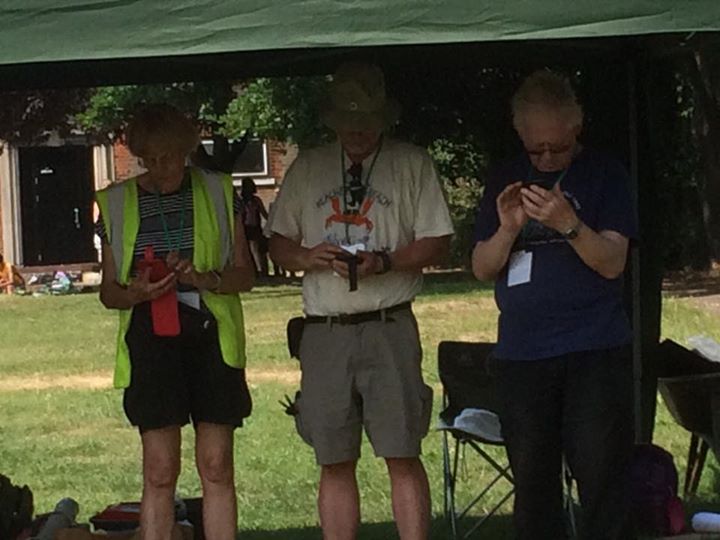
Home Front Legacy 1914-18 is a UK-wide archaeological recording project coinciding with the centenary of the First World War (World War One), coordinated by the Council for British Archaeology with funding from Historic England. The project enables everyone to investigate their local area and record the forgotten remains of the First World War Home Front. Using the tools we provide, local people can help to document and preserve our stories, and vulnerable remains for future generations. Your research can help the project gain a better understanding of the impact the Great War had on the buildings, landscapes and people back home on the Home Front. They need you to research and record your local Home Front sites, buildings and events. You don’t need any prior experience to get involved, and everything you will need is provided free via the Home Front Legacy website.
So far, volunteer contributors have recorded over 3,000 sites throughout the UK; including everything from requisitioned factories producing boots and uniforms for the military, farms that employed members of the Women’s Land Army, and buildings damaged by bombs dropped during the Zeppelin and Gotha bomber raids. There’s so much out there that remains to be re-discovered. Who knows what you might find! Simply register at www.homefrontlegacy.org.uk to find out more, access the Member Toolkit and online browser based recording app. You can also follow them on Twitter @HomeFrontLegacy and give our Facebook page a like at Facebook.com/HomeFrontLegacy.
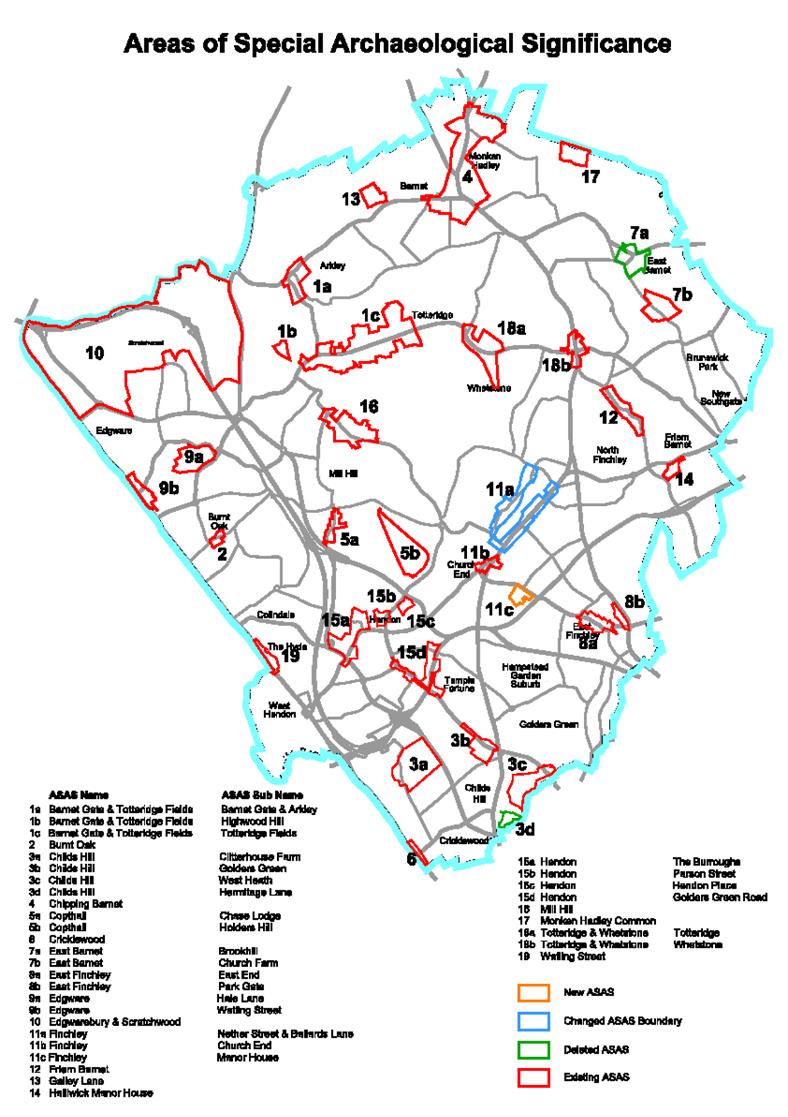
Barnet has two key planning documents that deal with the Boroughs archaeology. It has the Local Plan Core Strategy and the more detailed Development Management Policies. Both these documents were approved by Council in 2012 following an examination in public, to which HADAS contributed. What do these documents say and how can we use them to further the interests of Archaeology in Barnet?
The core strategy has warm words to say about Heritage in Barnet noting that the borough has a broad range of ‘heritage assets’ including Conservation Areas, Listed Buildings, Registered Historic Parks and Gardens, Locally Listed Buildings, Scheduled Ancient Monuments, a Historic Battlefield site and Local Areas of Archaeological Significance. These assets “can be used to ensure continued sustainability of an area and promote a sense of place.”
The Core Strategy notes that Barnet has a “rich archaeological and architectural heritage which includes the only Historic Battlefield (Battle of Barnet – 1471) in London.” In addition, there are “nearly forty sites of archaeological importance containing prehistoric, Roman and medieval remains.” In terms of buildings of historic and architectural importance in Barnet there are over 2,200 Listed Buildings and 1,600 buildings on the Local List. (The Local List is under review – see the article by Vicky) There are “two Scheduled Ancient Monuments at Brockley Hill in Edgware and Manor House in Finchley, three registered Historic Parks and Gardens at St Marylebone Cemetery, Avenue House Garden and Golders Green Crematorium.”
The Core Strategy notes that Barnet’s archaeological heritage is a “valuable education and community resource. As Barnet changes it is important that development proposals in areas of archaeological significance help broaden our knowledge of the past as a result of properly conducted on-site investigations.” It all sounds promising. The detailed policies are contained in a separate document known as the Development Management policies and DMO6 – Barnet’s Heritage and Conservation is the one to watch. (Copy of this policy at end of this piece.) The preamble to the policy comments that archaeology is “vulnerable to modern development and land use. Archaeological remains above and below ground level, and ancient monuments, are important surviving evidence of the borough’s past, and once removed they are lost forever.”
Barnet with assistance from English Heritage (via the Greater London Archaeology Advisory Service – GLAAS), the Museum of London and the Hendon and District Archaeological Society (HADAS), has identified five prehistoric, four Roman and thirty medieval sites containing archaeological remains of more than local importance. These have been grouped into nineteen ‘Local Areas of Special Archaeological Significance’. (See map below)
Development proposals in these areas will need to provide detail in consultation with GLAAS of how they will investigate, catalogue and where possible preserve the remains in situ or in a museum as part of any application. It may also be appropriate for HADAS to be consulted.
Barnet accept that “discovery is an important basis of archaeology.” They continue that “when researching the development potential of a site, developers should, in all cases, assess whether the site is known or is likely to contain archaeological remains. Where there is good reason to believe that there are remains of archaeological importance on a site, we will consider directing applicants to supply further details of proposed developments, including the results of an archaeological desk-based assessment and field evaluation.”
Barnet further remark, “where important archaeological remains are found the council will seek to resist development which adversely affects the process of preserving the remains on site. Where this is not possible mitigation which may include excavation, analysis of remains and public dissemination of results will be expected by an archaeological organisation with approval from the GLAAS and the council before development commences. If permitted, the loss through development of any archaeological remains will need to be recorded in line with para 141 in the NPPF. (National Planning Policy Framework) Planning conditions or a legal agreement will be used to secure this.
Overall the Framework for considering Archaeology in Barnet appears strong. The practical application of the policy by the planning department does not always appear to fully reflect the fine words. Sterling work by HADAS members tries to keep the archaeology banner flying high.
Over the years many developers in Barnet have submitted desk top appraisals on sites prior to development and some field reports have been completed. Using these, along with site visits, historical research etc. I’m proposing that we establish a HADAS Research Group to start in the autumn, on Sunday mornings at Stephens House, with the intention of reviewing all 19 of the Boroughs “Local Areas of Special Archaeological Significance”. Partly this will be so that we can proactively identify sites where we know in advance that we will want detailed archaeological work to be undertaken but also to prepare ourselves for the update of Barnet’s planning policies which will begin in the next 18 months or so and to which we can put detailed evidence of existing areas and possibly also identify new ones for inclusion.
Interested in getting involved in this research? Email me at the following address: roger.chapman99@btinternet.com
PS There are plenty of acronyms and jargon used in the planning process and as a practicing planner of over 40 years I may have fallen into the trap of using too much of it above. If you join the Research group I’ll let you into the secret of why planners use so much jargon. In the meantime you should get to know one more term because Historic England have determined that all Boroughs across London should now call their defined Areas not as “Local Areas of Special Archaeological Significance” but as “Archaeological Priority Areas.”
| Policy DM06: Barnet’s heritage and conservation |
| a. All heritage assets will be protected in line with their significance. All development will have regard to the local historic context. |
| b. Development proposals must preserve or enhance the character and appearance of 16 Conservation Areas in Barnet. |
| c. Proposals involving or affecting Barnet’s heritage assets set out in Table 7.2 should demonstrate the following: |
| • the significance of the heritage asset |
| • the impact of the proposal on the significance of the heritage asset |
| • the impact of the proposal on the setting of the heritage asset |
| • how the significance and/or setting of a heritage asset can be better revealed |
| • the opportunities to mitigate or adapt to climate change |
| • how the benefits outweigh any harm caused to the heritage asset. |
| d. There will be a presumption in favour of retaining all 1,600 Locally Listed Buildings in Barnet and any buildings which makes a positive contribution to the character or appearance of the 16 Conservation Areas. |
| e. Archaeological remains will be protected in particular in the 19 identified Local Areas of Special Archaeological Significance and elsewhere in Barnet. Any development that may affect archaeological remains will need to demonstrate the likely impact upon the remains and the proposed mitigation to reduce that impact. |
Here is the new poster for our finds course which will start again in October 2017. We have still a small number of places available.
This course is a wonderful way to improve your ability to recognise and identify types of pottery, clay pipes, glass and other types of finds. The objectives of this course are to identify, quantify and record the finds from Lant Street (LNT99) and well as to bring the whole assemblage up to the current standards required by the London Archive and Research Centre (LAARC). We processed nearly half the assemblage during last year’s course and were very impressed with the range and quality of the finds. It will be interesting to establish the likely date of the deposits and their relationship with the four early 19th century houses known to be on the site. Finds in Focus
Hendon & District Archaeological Society Finds Group
Course tutor: Jacqui Pearce BA FSA MCIfA
A 22-week course in post-excavation analysis to be held at Avenue House Stephens’ House and Gardens, East End Road, Finchley on Wednesday evenings, 6.30–8.30, starting on 4 October 2017 This year we will continue recording the diverse and extensive collection of finds from the 1999 Birkbeck College training excavations at Lant Street in Southwark (LNT99). This rich artefact assemblage is focused chiefly on the post-medieval period, with large collections of pottery, clay pipes, glass and other items. Regular presentations and professional tuition will be provided throughout the course. This is an ideal opportunity to gain––or increase––your experience of working with and handling a wide variety of archaeological finds, as we make a complete record of the excavated material ready for deposition in the LAARC. We will also be aiming to look at the finds in the context of the site and its development over time, and will have access to the full site archive throughout the course.
All are welcome, whether or not you have experience of working with archaeological finds!
Course fee: £295 for 22 sessions. To book, contact Don Cooper (olddormouse@hotmail.com; tel. 020 8440 4350) or Jacqui Pearce (pearcejacqui@gmail.com; tel. 020 8203 4506). Please make cheques payable to HADAS and send to Don Cooper, 59 Potters Road, Barnet EN5 5HS.
Issue No 309 January 1997 Edited by Liz Holliday
A happy and peaceful New Year to all members, their families and friends
DIARY
Tuesday January 14
Archaeology under the river alluvium of south east England
by Dr Martin Bates
Tuesday 11 February
A History of Hertfordshire by Tony Rook
Meetings are held
8pm for 8.30pm Drawing Room at Avenue House, East End Road, Finchley, N.3
Visitors are always welcome
CHRISTMAS DINNER
Hearsay evidence suggests a good time was had by all – it must have been quite a session as the
full account is still being written! Full report next month!
MEMBERS NEWS
We are sorry to hear that Gill Baker is back in hospital. Good wishes go to her from us all.
GARDEN ARCHAEOLOGY
Report of November’s lecture by Muriel Large “A garden is a lovesome thing, Got wot” – a cliche which does little justice to the skill and dedication archaeologists devote to their search for early gardens hidden under neglected present ones. In his talk, Brian Dix, Head of Archaeology for Northamptonshire, provided an absorbing account of how layers of grass and topsoil in the gardens of stately homes can be peeled away to reveal how past ages gardened. The classic example was, of course, Hampton Court. Here, William III’s garden plans had originally reworked the area thoroughly, to produce a slope down to the Thames. This allowed the king to see the river from his first-floor apartments and loyal subjects on the towpath could be suitably impressed by views of the palace. The work not finished until after the king’s death, occupied a team of gardeners much larger than the group who re-created it. Among the odd discoveries was the fact that the garden was double-dug in the recommended fashion near to the palace, but further away the less deep the digging and by the towpath only the top four or five inches of topsoil had been cultivated. There was also the problem of the paths; originally of sand, they had to he swept by a hoard of gardeners as soon as the courtiers and Royal family went indoors, to obliterate footmarks and restore the garden’s pristine condition. Hardly on option these days, with 750,000 visitors each year! Sand was used in the restoration for the sake of its colour but it was blended with clay for ease of maintenance.
A magnetometer and sensing equipment was used to identify the original layout, underneath the overgrown yew trees, which had been in-filled with shrubs and flowers by the Victorians. Mercifully, the garden was fully documented as originally laid out, although there was the perennial restoration problem – to which period should the reconstruction relate?
With the changes in levels, flights of steps had to be introduced where traces of the original steps were found and 33,000 box seedlings were planted to outline the overall pattern. The crowning glory was the reconstruction of Queen Mary’s Bower, an impressive 120 foot tunnel arbour or pergola, decorated this time with the arms of Queen Elizabeth II. It may be that in the future, as the planting grows, the fine woodwork will disappear under the greenery. At present, the arbour is a remarkable piece of work itself.
An unusual role for archaeologists, to construct rather than uncover and dissect, but they were entrusted to lay out the pattern and oversee the planting.Mr. Dix also described similar, although less extensive, work carried out at a chateau in Burgundy and a Jacobean house in Northamptonshire. Those of us digging our suburban gardens, unearthing broken bricks and pieces of tile, may sometimes feel that we are engaged in archaeology rather than horticulture! However, we can at least draw comfort from the examples that have resulted in new life for long-vanished gardens.
The winter edition of CADW’s journal “Heritage in Wales” includes a report of the recent discovery of a secret garden at Haverfordwest Priory. A copy of the journal will be deposited in the HADAS library.
MYSTERIES OF ANCIENT CHINA: new discoveries from the early dynasties
This exciting exhibition is at the British Museum until 5 January. It is the first great loan exhibition of antiquities from China to be seen in London for twenty years, bringing together recent startling archaeological discoveries which radically change perceptions of China’s early history. Spanning the period 4500BC to AD 200, the exhibition explores ancient Chinese beliefs about life and death. The exhibits, which come from several distinct regions of China, show that images of men and spirits inspired some of the greatest masterpieces of ancient Chinese art. Figures with large projecting eyes, cranes with towering antlers, spirits with feathered wings and suits of jade are strange and beautiful creations, many of them quite literally, mysteries.
CBA Conference: ROMAN LONDON: RECENT ARCHAEOLOGICAL RESULTS FROM THE CITY Report by Peter Pickering
Several HADAS members attended this conference on 16 November. Several others were unable to get in – it was a sell-out_
The speakers, almost all from MoLAS, varied, but were usually both good and interesting. Many new ideas – new at least to me – were put forward and I think members may be interested to learn about some of them.
Nick Bateman quoted Vitruvius, the Latin writer on architecture, who divided public buildings into three categories: those for defence (walls); those for religion (temples) and those for convenience (baths, forums, amphitheatre and the like). The absence of state temples in Roman London has often been remarked, bit an early and perhaps short-lived one has been found west of the Huggin Hill bath complex, with an unexplained building between them. The Basilica building was, despite the reputation of Roman builders, a shoddy piece of work, which had required a lot of repair during its life.
Jane Sidell reported on the environmental evidence from the East London Roman Cemetery. Work on the biological material buried with people in graves has had remarkable results_ Many graves (especially cremation rather than inhumation burials) contained food, but one had two separate deposits – one with half a piglet and a goose, and one with the other half of the piglet and a dressed chicken. Graves in different parts of the cemetery contained different types of pulses. There were pits that contained animals but no human bodies – one with a horse, a dog and a red deer, close together in a circle, and another with lots of frogs and a heron. Perhaps there had been this pit with water in it; frogs had colonised it and then a heron saw the opportunity of a meal, swooped in and was unable to spread its wings so as to fly out; but if so, why then was there nothing else in the pit? Was there some strange ritual? Jane Sidell also illustrated two imports into Roman London – one of stone pine cones (perhaps for making pesto sauce from the kernels) and the other of cannabis (for rope or medicinal purposes).
David Sankey attempted to convince us that he had identified a late Roman cathedral, from a ground-plan very like that of the early St. Theela’s cathedral in Milan. Those unconvinced could believe it was a large warehouse, but even that, he argued, was evidence that London was much more important in the very late period than common opinion would have it.
Bruce Watson talked about the notorious Dark Earth. Pollen analysis has shown that this is not the remains of Late Roman gardens, and that there were not trees about. His theory was that it was evidence simply of waste land.
Finally, Professor Martin Millen from Durham talked about the status of Roman London and warned us against reading the present into Roman administrative structures. A study of the so-called provincial capitals from the western part of the Roman Empire demonstrated their great differences. He even thought that the statement of the geographer Ptolemy, that London was a town of the Cantii and therefore subordinate to Canterbury, might be legally right (it gets some support from an inscribed tablet recording an inquiry into the ownership of a wood); he thought London was something of a “gold-rush” town, settled by Roman citizens who were traders from Gaul. Although the procurator of the province would he resident in London, and it was the hub of the road network, it was, he argued, not really the governor’s capital. The governor would often be out and about with the troops, and the centre of Britain for the purpose of the state religion perhaps always remained in Colchester.
CHURCH FARMHOUSE MUSEUM
The current exhibition features Construction Toys, dating from the middle of the 19th century to the present day. You will find early wooden building blocks, kits in all types of materials made by such firms as Sarnia, Lotts Bricks, Minibrix and Bayko. There is a wonderful crane made from Meccano specially for this exhibition. Lego UK generously lent two huge drums of bricks so that pupils from Sunnyhill JMI could make models for the exhibition. The whole school took part in a Lego day, and the results are on show.
Creating its own tradition, once again the dining room at Church Farmhouse is decorated as it would have been for a Victorian Christmas, with baubles, bangles, holly and ivy. The room looks as if the family have just got up from the dining table. Decorations stay up until Twelfth Night.
The Museum will be closed on Christmas Day and Boxing Day and also on 1 January. Construction Toys will be on show until 2 February.
NEWS FROM OUR NEIGHBOURS
Barnet & District Local History Society meet in the Wyburn Room, Wesley Hall, Stapylton Road, Barnet. At 2.45pm on Monday 6 January June and Jack Alcock will present History of the River Thames.
Enfield Archaeological Society welcome visitors to their meetings in the Jubilee Hall, junction of Chase Side and Parsonage Lane. Tea is served at 7.30; meetings start at 8pm. On Friday 17 January Ian Jones will be talking about Africa Proconsularis: Carthage and Rome in Tunisia.
The Wembley History Society will he learning about Science in 1824 and Today from Leslie Williams at 7.30pm on Friday 17 January at their meeting in the Church Hall, adjoining St.Andrew’s Church, Church Lane, Kingsbury.
The Finchley Society
meets on Thursdays at 7.45pm in the Drawing Room at Avenue House, East End Road, N3. On
Thursday 30 January Joanna Corden will be revealing Finchley from the archives
Pinner Local History Society will be holding a local history day on Middlesex Manors – then and now on Saturday 22 February from 10.00am – 4.30pm at the Winston Churchill Hall, Ruislip. Tickets cost £4. Contact Mrs Beryl Newton on 0181-866 3372.
This spring, Enfield Preservation Society will publish Fighting for the Future: the story of the society 1936-1996. There book includes 229 photographs and prints, many never published before. The book will cost £13.50 (plus £3 p&p) if you place an order with payment by 28 February. Contact Mrs Irene Smith, 107 Parsonage Lane, Enfield, Middx., EN2 OAB
EARLY BARNET AND ITS BOUNDARIES by Pamela Taylor
The early medieval history of Barnet – the manor and parish, not the London Borough – has always been very obscure, and until recently we had no information before the mid-twelfth century. The earliest part of the fabric of St Mary East Barnet has been dated c.1140, and this chimes well with the earliest known written reference, which comes in a papal bull from Adrian IV to St Albans Abbey granted in February 1156/7. (It says 1156 but is probably operating on the Julian rather than the Gregorian calendar). Bulls are known by their opening word(s), so this one, which begins with a phrase about the incomprehensible and ineffable divine majesty, is known as incomprehensible. It’s not as had as that: in fact it’s a detailed confirmation of the abbey’s privileges, (Adrian was a local St Albans boy made extremely good) and, unlike the abbey’s earlier bulls, includes a list of its churches, among them Barnet. This was at East rather than Chipping Barnet because the latter only developed after the building of the new main road to the north in the late eleventh or twelfth century, and especially after the abbots of S Albans obtained a charter to hold a market there in 1199. St Albans garnered charters of privileges from kings as well as popes, and the earliest known royal charter which mentions Barnet, again in a comprehensive list of the abbey’s properties, was granted by Henry II; it is undated (the English chancery didn’t yet regularly follow the excellent papal example), but has been assigned from its witness list to 1176. The local entry is particularly interesting because it reads “Barnet cum boscis de Scthawe, et Borham, et Huzeheog”. The woods of Southaw and Osidge were always later included within Barnet, but by the time we have regular records Borehamwood was part of the abbey’s manor of Aldenham Barnet’s boundaries with other St Albans manors were therefore still not immutable in the later 12th century, but from other references it has long been known that the separation from Friern Barnet (and with it the boundary between Herfordshire and Middlesex) was by then firmly in place. The bishop of London reclaimed what became known as Friern from a tenant in 1187 prior to granting it to the Hospitallers in 1199 (it was from them, via the French for Brothers, that it got its name).
None of the Barnets is named in Domesday Book, and until recently the only supposedly pre-12th century reference was a comment in the 14th century version of the St Albans house chronicle, the Gesta Abbatum, that William the Conqueror had punished its abbot’s rebellion by removin’ “all the abbey’s lands between Barnet and London stone (which is still to be found within the City, in Cannon Street). There were always considerable reservations about the source, but in the absence of other information it was accorded a degree of plausibility – and it would neatly have explained the separation of Friern. Now, however, the discovery in Brussels by a Cambridge don, Simon Keynes, of a 17th century copy of an otherwise lost 12th century St Albans cartulary, means that the story is exposed as a total myth, and that our knowledge is extended backwards to 1005.
All the deeds in the cartulary were in fact known from 13th century and later Latin copies, but the 12th century exemplar also contained some Old English versions and, more importantly, detailed boundary decriptions_ From these we now know not only that King Athelred’s grant to the abbey in 1005 of Waetlingcaster equates to Kingsbury in St Albans, but that the unnamed area of attached woodland which was part of the same grant equates to Barnet. The boundary description for Barnet is not totally identifiable, but it seems to follow the normal pattern of a circuit clockwise round from 12. The central part of the northern, and all of the eastern, side are unrecognisable, but from the point where the circuit reaches hyttes stigele, or Betstile, the rest is reasonably plain sailing. Betstile, the older name for New Southgate, is at the southern corner of the boundary between East and Friern Barnet. Better still, the next stretch north-westwards is described as “along the bishop’s boundary”, and it’s hard to imagine that this could be anyone other than the bishop of London. The boundary was copied twice, with minor variations (and it’s worth remembering that the
17th century copyist was floundering too); what follows is an amalgamated version, with the symbols my processor can’t cope with modernised to th, and some added semi-colons.
This synt thes wealdes gemaere into thære ealden byrig. Ærest of hæwenes hlæwe; andlang enefeldinga gemære; on scirburnan, of scirburnan; to aetheleof hæcce. Of tham hæcce; to æscbyrthes heale, of tham heale; andlang eadulfingtuninga gemære; to r (or s)eodes gate, of tham geate, on byttes stigele, of byttes stigele; andlang thaes biscopes gemære; on wakeling mor, of tham more; on aggangeat, of tham geate; on thane steort; æt bræneten, andlang bræneoten; a be tham geondran stæthe; on thæne sihter, of tham sihtre; æt tatehrycges ænde; andlang heanduninga gemære; on grendeles gat, of grendeles gate; andlang scenleainga gemære; on ruge beorc lege, of beorc lege; on hæthlege, of hæthlege; a be wyrtruman.
The structure of this isn’t at all difficult, and from Betstile round to Hadley you can plot it on the map. You either walk on…of (onitaff or up tolaway from), or be, (by), each marker, or you walk andlang, (along) a longer stretch. Taking the individual names in turn: a hlæwe is a mound or barrow, and it’s very tempting to identify this one with the possibly Iron Age earthworks in Hadley Wood; along the Enfield boundary is readily comprehensible, although the boundary itself may later have shifted a little; the shire stream is presumably Pymmes Brook, whether you go along or across it is unclear, though perhaps more probably along, not least because “shire” implies it was used as a boundary – but no one has been able to make any sense of this bit on a map; Athelof s hatch (gate) and Ashbirt’s hale (corner) are lost, but conspicuous turning points along a boundary were usually marked, and the latter could therefore be the sharp north-eastern corner; along the Edulfington boundary is explained by another major discovery from the cartulary, that Edulfington is what was later known as Edmonton; r/seodes gate cannot, according to the experts, transmute to Southgate; Betstile and the bishop’s boundary were dealt with above; wakeling mor must have been swampy, and therefore presumably in a dip; Agate is more or less at the junction of Northumberland Road and the A1000; steort means a spit of land; to and along the Brent; cross to the further hank (geondran stæthe); along the ditch; at Totteridge’s end; along the Hendon boundary; Grendels Gate is the older name for Barnet Gate, along the Shenley boundary; ruge beorc lege (rough birch clearing) is Rowley; on/off Hadley gives us a new early reference to the place-name, but the fact that it’s not given as “along the Hadley boundary”, and the general difficulty of plotting the northern and eastern side of the circuit, suggests something less than an established settlement; by the crop clearing.
So there, for the moment, we have it. In 1005 King Æthelred granted the abbey land which had previously been his – Kingsbury and its attached wood at Barnet, and by then the bishop of London was already holding Friern. It’s a lot better than our previous knowledge, but of course raises endless new questions. For anyone who wants to take it further, references and more detailed information are available at the Local Studies and Archives
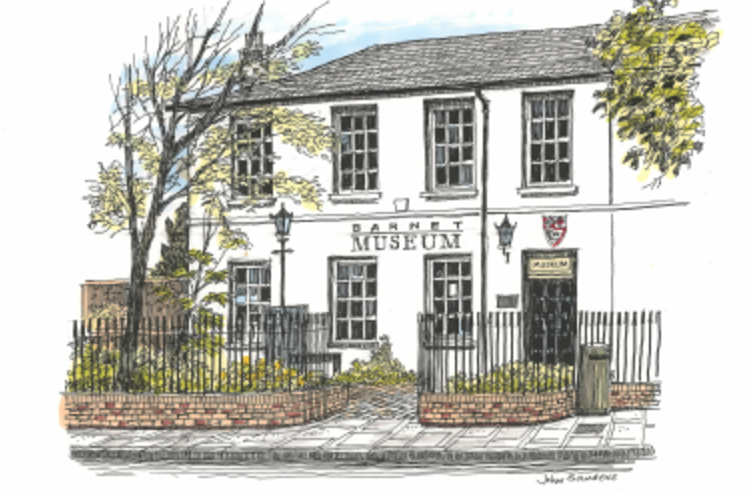
Number 555 June 2017 Edited by Sue Willetts
HADAS DIARY – LECTURE PROGRAMME 2017
Tuesday 13th June 2017: 7.30 pm ANNUAL GENERAL MEETING – See below
NB Summer break from lecture season – lectures re-start in October
Monday 25th-Friday 29th September: HADAS Trip to Frodsham.
Tuesday 10th October 2017: “The Curtain” Playhouse Excavations, by Heather Knight,
MOLA
Tuesday 14th November 2017: The Battle of Barnet Project, by Sam Wilson.
Lectures are held at Avenue House, 17 East End Road, Finchley, N3 3QE, and start promptly at 8 pm, with coffee/tea and biscuits afterwards. Non-members: £1. Buses 13, 125, 143, 326
& 460 pass nearby, and Finchley Central station (Northern Line) is a 5-10 minute walk away.
Reminder: Annual General Meeting:
Tuesday 13th June at 7.30pm at Stephens House and Gardens (formerly Avenue House). Please note the slightly earlier start than usual.
If you are unable to attend please register your apologies with the Secretary Jo Nelhams by email or phone. Details on the back of the Newsletter. AGM papers were distributed / attached to the previous newsletter.
We hope to see many of you there, also to support the President Harvey Sheldon, who will lead a presentation, after the AGM, on the excavation at Lant Street in Southwark in 1999, the finds of which are being studied and are being recorded by the HADAS Finds Group. Please come and support your Society. Jo Nelhams
HADAS Christmas Party
The HADAS Christmas Party will take place on Sunday 10th December at Avenue House. As in 2016, we will have a cooked Christmas Lunch in the Drawing Room. More details will follow nearer the date.
“Bus pass” Outings Jim Nelhams
Members will be aware that we have not had any one day outings recently.
One reason for this is that hiring a coach for a day now costs around £600. This cost has to be shared between those on an outing, so if we have 40 people, it’s £15 each, and for just 30, it’s
£20. “Bus pass” outings are intended to overcome this problem.
In simple terms, we agree a time and destination, and people make their own transport arrangements. We suggest a meeting place and visit as a group. So if the outing is within the London area, those with a bus pass, which is probably the majority, will have no transport costs to pay. We would like to try it and see how it works.
The suggested destination for our first trip is the Tunnel exhibition at the Docklands Museum. It is open until December and features finds from the Crossrail project and information about the construction. The Museum and exhibition is free, though donations are welcomed. The Museum also has a permanent display about docklands.
I have already circulated the idea to our email list and had over 25 positive responses.
So that we can give those that work a chance to come, I am suggesting that we try two dates (at no extra cost), Thursday 29th June and Sunday 2nd July. If you would like to come along, please let us know which date you would like. If you cannot make either, we might consider a third date if sufficient can make it. Please call me or Jo, or email. Our contact information appears at the back of this newsletter. Friends and family would be welcome.
Our planned meeting point would be West India Quay station on the Docklands Light
Railway. The trains are from Bank station with the destination of Lewisham. Meeting time at 11:00. We could have an interim meeting point on the DLR platform at Bank Station at around 10:30. Fuller information can be sent later.
The Museum has a small café but there is a pub next door and several restaurants nearby, or you can bring your own lunch.
After viewing the museum, you would be free to make your own way home, or to visit somewhere else.
ArchaeologyProjects
Barnet Museum
The Museum has appointed a coordinator for their newest heritage project – on the Battle of Barnet – to explain the battle of 1471. This will be led by Helen Giles, who has more than 17 years’ experience working in museums and heritage. The project has secured a lottery grant of £98,600 to educate the community and develop resources and activity about the battle and its role in English history. Ms Giles said: “I am sure that for many people Barnet’s role in the Wars of the Roses, and its connection to Richard III, is an untold story.” “My aim will be to do all I can to help the dedicated team at Barnet Museum build on their local heritage.”
Copped Hall Trust Archaeological Project (CHTAP)
CHTAP will be running its usual series of taster weekends and field schools at Copped Hall (on the edge of Epping Forest) – an important archaeological site with a complex sequence of building phases, its recorded history starts in the 12th century. These weekends and field schools will take place on the site of the earlier mansion, ‘Old’ Copped Hall, which stood at the northern end of the gardens and was demolished in 1748. The site is mainly Tudor, but previous archaeological finds have dated from the prehistoric all the way to modern times. The three taster weekends in July will be open to all, including complete beginners, and are designed to teach the absolute basics of archaeology and excavation. In August, two five-day field schools will be held for those who have already learnt the basics of excavation and recording and wish to develop their skills further. The aim of the schools will be to advance the archaeology of old Copped Hall.
Taster weekends: Archaeology: 15-16 or 22-23 July, Geophysics: 29-30 July 2017.
Cost: Taster weekend: £60 per person
Field schools : Saturday 12 – Wednesday 16 August; Saturday 26 – Wednesday 30 August. Field school: £100 per person (non residential) for non-West Essex Archaeological Group members and £80 for WEAG.
For more information or to make a booking contact: Mr Andrew Madeley (Tel 020 8491
6514) email: coppedhalldigs@weag.org.uk or www.weag.org.uk/events_fieldsschool.html
British Archaeology festival – This year from 15-30 July 2017.
The Council for British Archaeology’s Festival of Archaeology has hundreds of events celebrating archaeology. There are currently (22.5.17) 11 events listed for Greater London for all periods of Archaeology: For more details, please check the general website
COLAS at Tower Hamlets Cemetery Park Sat 1st July 2017
Young archaeologists, thrilling discoveries at Kingston Museum Sat 15th July 2017
COLAS at Nunhead Cemetery Open Day Sat 20th May 2017
Interactive archaeology tour at Fulham Palace Sun 23rd July 2017
Blood Royal: Picturing the Tudor Monarchy Mon 24th July 2017 – Fri 25th Aug 2017
Londinium: The Roman city Fri 28th July 2017
Sensory town tour with Kingston Museum Fri 28th July 2017
Upminster Windmills Archaeology Fun Day Fri 28th July 2017
Ice Sunday at London Canal Museum: opportunity to enter the ice wells Sun 30th July 2017
Roman days at Brent Museum Various dates
Upminster Windmill’s Victorian garden dig and talk Various dates
Conference: Sculptural Display: Ancient and Modern
organised by the Hellenic and Roman Societies Wed 28 June 2017, 10:30 – 18:30: Beveridge Hall, Senate House, University of London, Malet St, London WC1E 7HU.
10.30 Doors to Beveridge Hall open
11.00 Welcome – Professor Catharine Edwards (President, Roman Society)
Chair and respondent – Dr Lesley Fitton (British Museum)
11.15 Professor Olga Palagia (National and Kapodistrian University of Athens): Sculptural
Display in ancient Greek temples
12.00 Dr Kenneth Lapatin (The J. Paul Getty Museum): The Sculptures of the Villa dei Papiri at Herculaneum – and Beyond
13.00 Lunch
14.00 Dr Thorsten Opper (British Museum): Sculptures from Hadrian’s Villa during the Age of the Grand Tour
Chair and respondent – Dr Michael Squire (King’s College London)
15.00 Dr Paul Roberts (Ashmolean): From the Parian to a pug: The Arundel marbles in the Ashmolean
15.45 Tea
16.15 Dr Bruce Boucher (Soane Museum): The historic display of sculpture at the Soane
Museum
17.00 Professor Whitney Davis (University of California at Berkeley): The Multifacial
Conundrum in Classical and Modern Sculpture
18.00 Closing words – Professor Robert Fowler (President, Hellenic Society)
Admission is free, and includes a sandwich lunch and tea in the afternoon. It is necessary to register for this event using the eventbrite link
Advance notice:
Conference: Celebrating 50 years of the journal Britannia is not
until Saturday 4th November in Senate House, University of London, but this is bound to be very popular so if you are interested – please register as soon as possible.
While the event is free, there is a small charge if you would like to have lunch. To book lunch please contact office@romansociety.org
Exhibitions:
Tunnel: the archaeology of Crossrail
As well as the exhibition at the Museum of London – Docklands there is also a new website which uses a series of 360-degree panoramic images from the exhibition and takes visitors on a journey along the route of the new railway, with photographs and footage captured during archaeological excavations. Ten new rotating images have also been released including: 8,000 year-old flint scraper tool from Woolwich; a Roman cremation urn, a disarticulated skull and bronze coin from Liverpool Street; a Tudor wooden bowling ball, a 16th Century ceramic mercury jar and a 18th Century Chinese Pearlware bowl all from Stepney Green.
University College London, Institute of Archaeology’s new MA in Museum Studies student exhibition, Sex and Symbolism:
This opened to the public on 8th May and runs until 27th April 2018 in the A.G. Leventis
Gallery of Cypriot and Eastern Mediterranean Archaeology, 31-34 Gordon Square, WC1H 0PY. It uses art, archaeology, and modern material culture to explore how seduction, sensuality, and sex have been represented through time.
Petrie Egyptian Archaeology, Malet Place, University College London, WC1E 6BT Different-perspectives: Archaeology and the Middle East in World
War One (16th May-30th Sep 2017).
World War I had a profound impact in and on the Middle East, the repercussions of which are still felt today. This exhibition touches on the significant, and often emotive, events and issues that took place. At the age of 61 Flinders Petrie tried to enlist for service but could only watch as those around him put on military uniforms and as battles were fought near to or in the places he knew so well in Egypt and Palestine.
Petrie was based in London throughout the war, opening a museum of Egyptian Archaeology at University College in 1915 shortly after major Zeppelin bombing raids. The exhibition has a series of panels which include:
Ways of Seeing about technical advancements in map making and aviation changed the war;
Petrie’s Pups explores what four of Petrie’s students did during the war, including becoming some of the first ‘monuments men’;
Voices from the Region considers the use of Arab and Egyptian archaeological workforces and the impact of the war on people in the Middle East;
The Role of Women sketches how women were involved, such as the intelligence agent Gertrude Bell and fundraiser Hilda Petrie;
Gathering Intelligence details the exploits of some of the intelligence agents, such as T. E. Lawrence and technical innovations
New Book Information
Clive Orton, Emeritus Professor of Quantitative Archaeology at the Institute of Archaeology, UCL has published his memoirs Degrees of Freedom: and other episodes in an archaeological life. Copies are available from Clive directly (email: c.orton@ucl.ac.uk) at £5 (cash / cheque only please) or can be posted for an extra £1 charge.
Books on Offer
Two books in good condition, available to the first person to ask:
Contact mary.rawitzer@talktalk.net
Symbols of Power – in the time of Stonehenge DV Clarke, TH Cowie, A Foxon (HMSO 1985). This beautifully illustrated and classic book derives from an Edinburgh exhibition in 1985. £12 upwards online.
The Upper Palaeolithic of Britain – A study of man and nature in the Ice Age (Vol. II only) John B Campbell (Clarendon Press, 1977) Full of useful analysis of climate and environment, Vol. II is all illustrations, maps, and gazeteers of sites and artifacts.
OTHER SOCIETIES’ EVENTS compiled by Eric Morgan
Sunday 11th June. Barnet Museum & Local History Society. Old Court House, behind Barnet Museum, Wood St., Barnet. Medieval Festival including re-enactments, music. Free entry
Saturday 17th June 11 am – 5.00 pm. Friary Park Community Day. Friary House,
Friary Park, Friary Road, Friern Barnet, N20 ONR. Entertainment including Local History. Finchley Society will have a stand. http://www.communityfocus.co.uk
Sunday 25th June The East Finchley Festival. Cherry Tree Wood, off High Rd, East Finchley, N2, opp. Station for entrance. Entertainment & stalls including ones for Finchley Society & HADAS.
Saturday 1st July 10.00 am – 4.00 pm. Christ Church, North Finchley. Corner High Rd / Christchurch Ave. ‘Open House’ celebrating 150th anniversary of the Church. Tours, exhibition, refreshments etc. Sunday 2nd July. Bishop of Edmonton will conduct the morning service, followed by a street party.
Saturday 1st July 8.15 am. Barnet Museum and Local History Society. Coach outing to
Charleston House & Lewes. Charleston Houe was the home / garden / meeting place for The Bloomsbury Group. The interior was painted by Duncan Grant & Vanessa Bell. The visit includes refreshments and a private tour of the house – thereafter a visit to Lewes arriving
c.1.30 pm – leaving c.5.00 pm. Departure is from The Everyman (formerly Odeon) cinema, Great North Rd, Barnet. Cost is £31.00. Send cheques payable to Barnet Museum and Local History Society with details of names, address, phone number to: Dennis Bird, 87 Hadley Highstone, Barnet, EN5 4QQ. Tel 020 8449 0705 who will phone you to confirm booking.
Saturday 1st July 8.30 am. Hornsey Historical Society, Coach outing to Pevensey Castle & Battle Abbey led by Stephen Hooking (of Battlefield Tours) which will cover the Norman invasion, Pevensey Castle, history of guns / gunpowder and the Battle of Hastings. Cost: £39.75 and covers coach, entrance fees, walk around Senlac Field and services of tour guide, but not including lunch. Departure from Queen’s Ave, Tetherdown Junction, Muswell Hill off Fortis Green Rd or The Old School House, Tottenham Lane, N8 7EL (corner Rokesby Avenue) at 8.45 am. Please state pick-up point when booking.
Email events@hornseyhistorical.org.uk or ring / text 07757 414363 stating phone number/ email. For confirmation and final details send SAE only if have no email to Rachael Macdonald, 13A Palmerston RD, Bowes Park, London, N22 8QH. Cheques to Hornsey Historical Society
Saturday 1st July & Sunday 2nd July 12.00 – 7.00 pm. East Barnet Festival. Oak Hill Park, Church Hill Rd, East Barnet. Community & craft stalls plus entertainment.
Thursday 6th July 8.00 pm. Barnet Museum and Local History Society. Pennefather Hall, Battle of Barnet, Battlefield poetry. Talk by Clare Mulley, Battlefields Trust poet in residence reading from her work including “Thorn Kings”. Tickets on door £3.00 members, £5.00 non-members. Refreshments.
Friday 7th July 7.45 pm. Enfield Archaeological Society. Joint meeting with Edmonton Hundred Historical Society. Jubilee Hall, 2 Parsonage Lane, Junction with Chase Side, Enfield, EN2 OAJ Geoffrey Gillam Memorial Lecture: Digs at Upminster Windmill 2016. Les Capon, AOC. Visitors £1.50 Refreshments, sales and information 7.30 pm
Sunday 9th July. Bothy Garden open, Avenue House see entry for 16th July.
Tuesday 11th July 7.45 pm. “Virtual Fieldwork using Google Earth” by Ian Watkinson.
Now meeting at a new venue: Finchley Baptist Church Hall. 5 East End Road, Finchley, London N3 3QL. This is almost opposite Avenue House/Stephens House. Limited parking at the Hall but free parking in East End Road.
Wednesday 12th – Sunday 16th; Tuesday 18th – Sunday 23rd July. Enfield Archaeology Society: Extended excavation at Elysing Palace (Forty Hall) Enfield EN2. If you are interested in getting involved contact the Fieldwork Director, Dr Martin Dearne research@enfarchsoc.org, Also see Enfield Archaeological Society – which has information / photographs from the 2016 season.
Sunday 16th July 12:00 – 17:00. Avenue House, (Stephen’s House & Garden) 17 East End Road, N3 3QE. Summer Garden Fête. A day of fun and games with food, craft stalls and a brass band. Admission to the gardens is free. There will be community stalls including HADAS. Sunday 9th July The Bothy Garden will be open from 1pm – 5pm. Lunch is available in the House from 12-3.00 pm. NB HADAS members meet in the basement room most Sundays from 10.30 am
Tuesday 18th July 11:00 – 15:30. Mill Hill Historical Society. Visit to the Musical Museum and the Steam & Water Museum at Kew http://musicalmuseum.co.uk/page/26-visiting. Closing date for booking 30th June. Meet 11:00 at the Musical Museum, 399 High Street, Brentford. Morning: Guided tour Lunch: Own arrangements – each museum has a café, otherwise there are pubs by Kew Bridge or take a picnic to enjoy by the river. Afternoon:
Visit to the Steam & Water Museum, Kew Cost: £16.50. Send cheque made payable to Mill Hill Historical Association and SAE to Julia Haynes, 38 Marion Road, Mill Hill, NW7 4AN. For info / bookings: 020 8906 0563 or email haynes.julia@yahoo.co.uk
Saturday 22nd July 12.00 – 5.00pm. Forty Hall and Estate is hosting a Public Open Day with the Museum open and a stall from the Enfield Archaeological Society. The Forty Hall oral history project will be launched. Other events include interactive park trails, illustrated talks on the landscape and history of the park, guided walks, barbeque / refreshments. Free admission. Part of the Love Parks Week.







